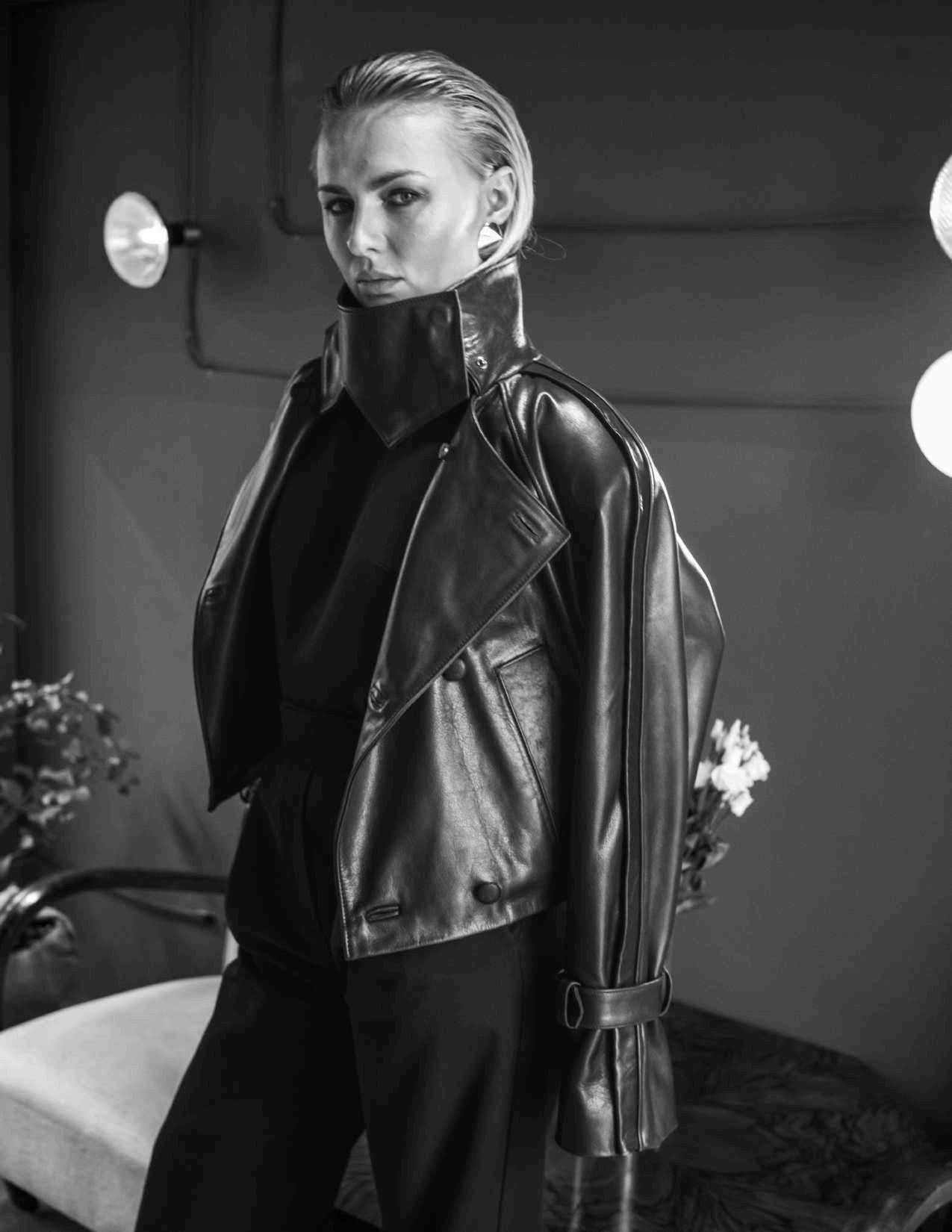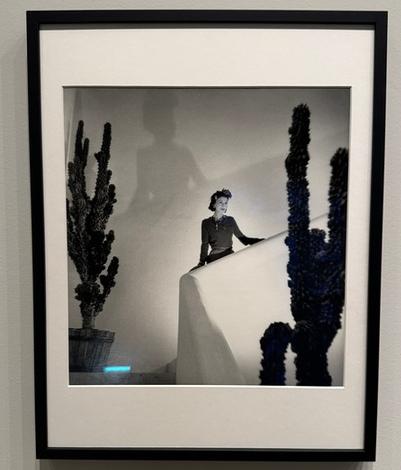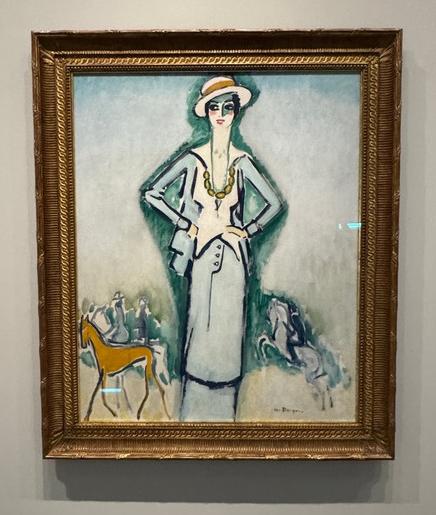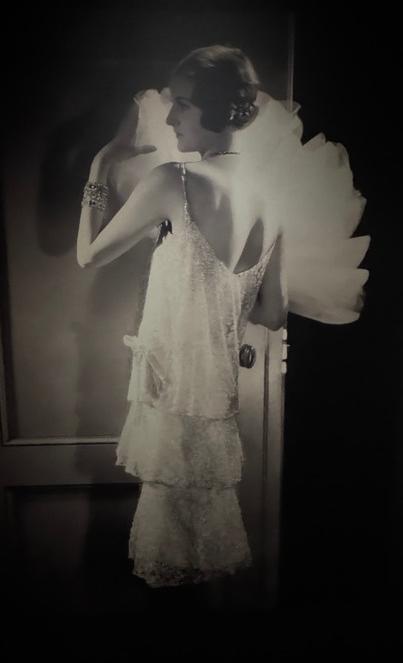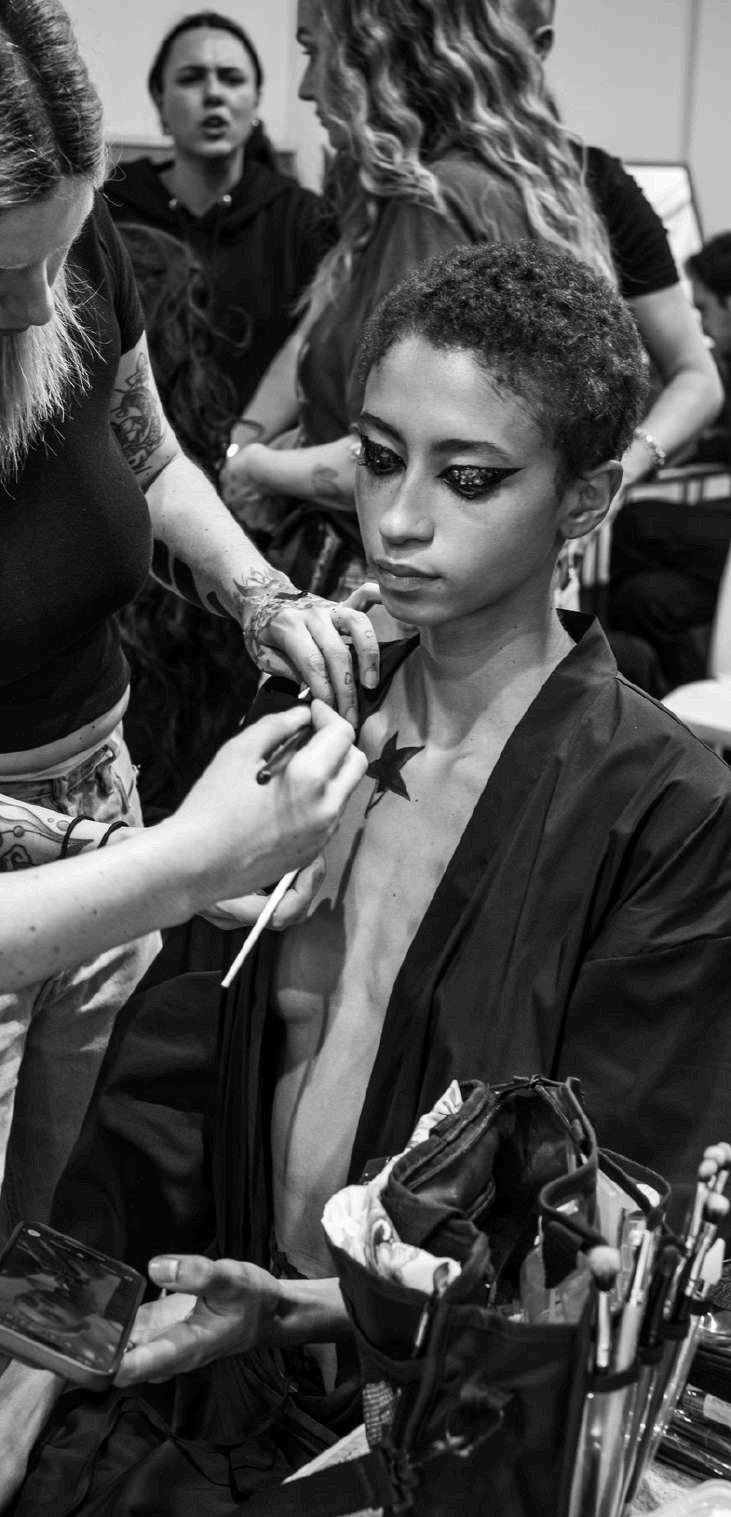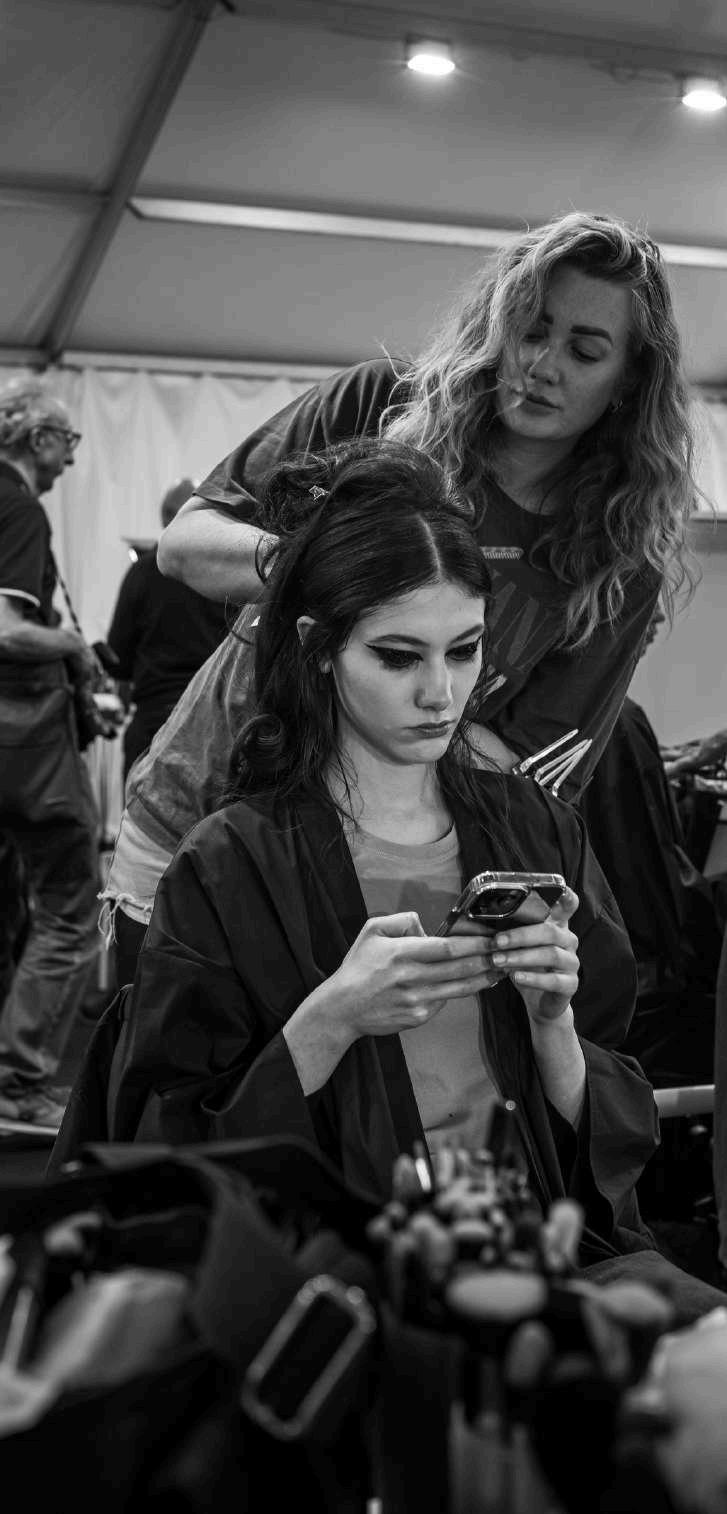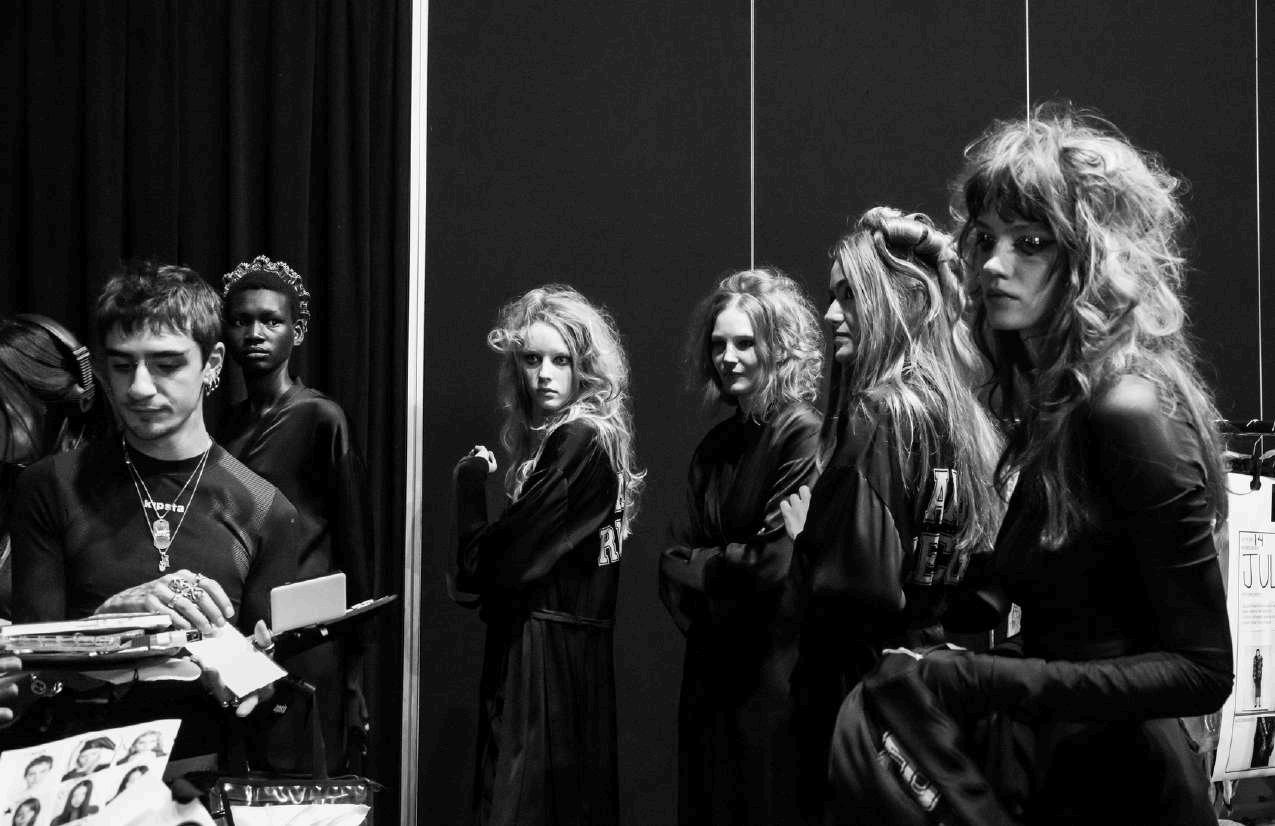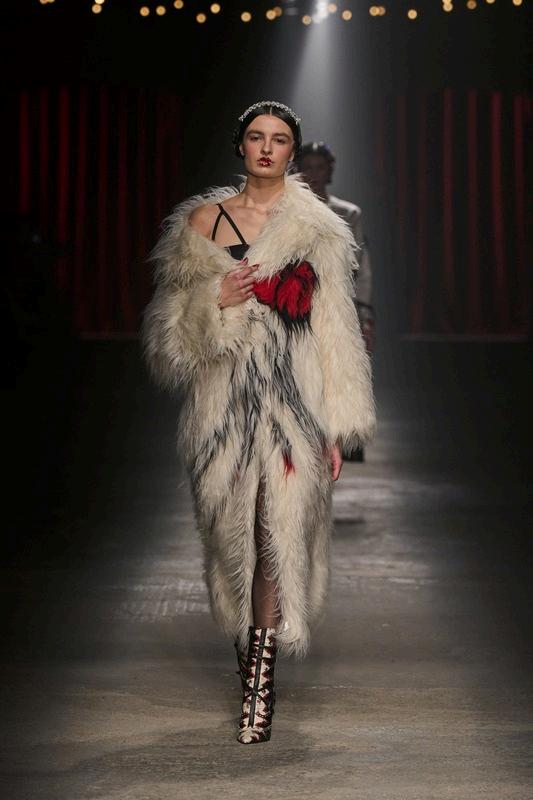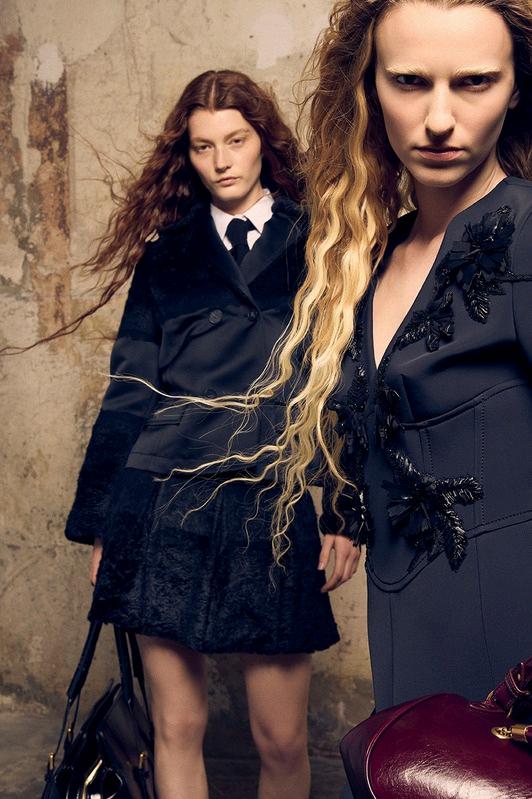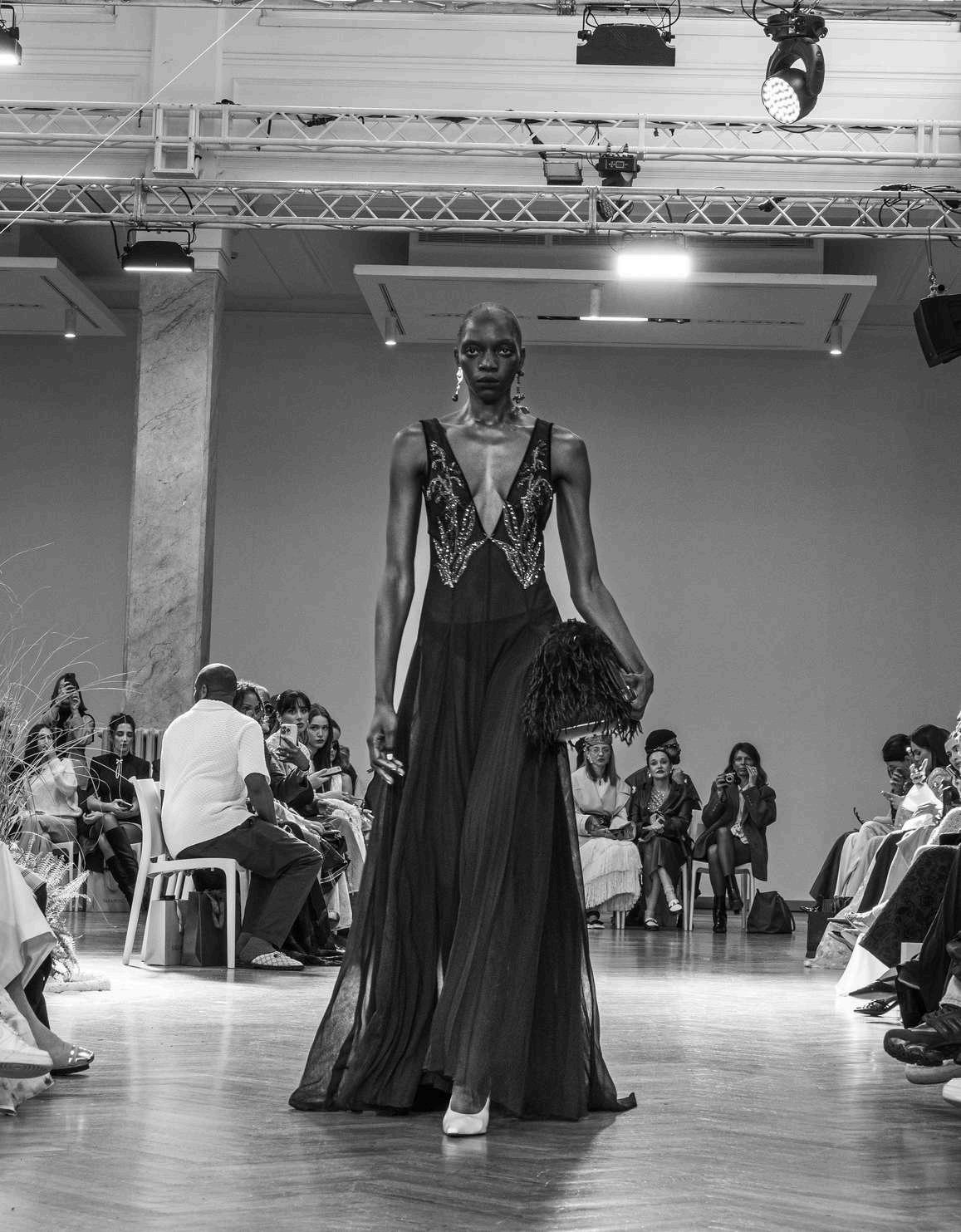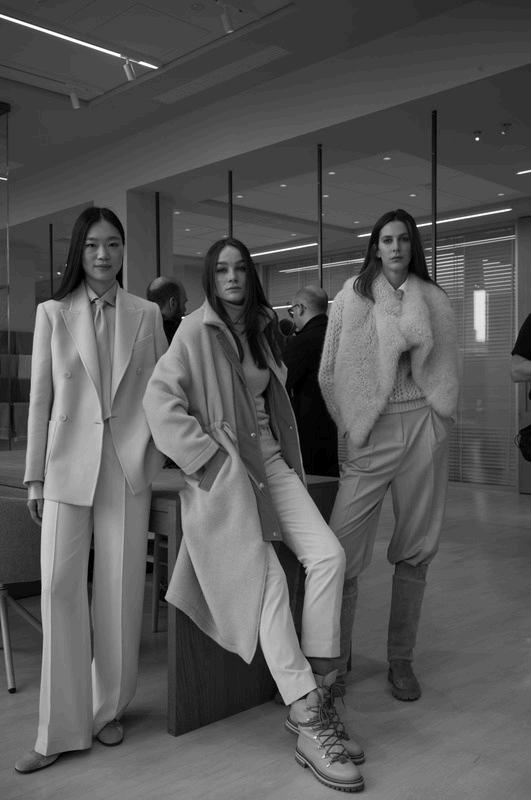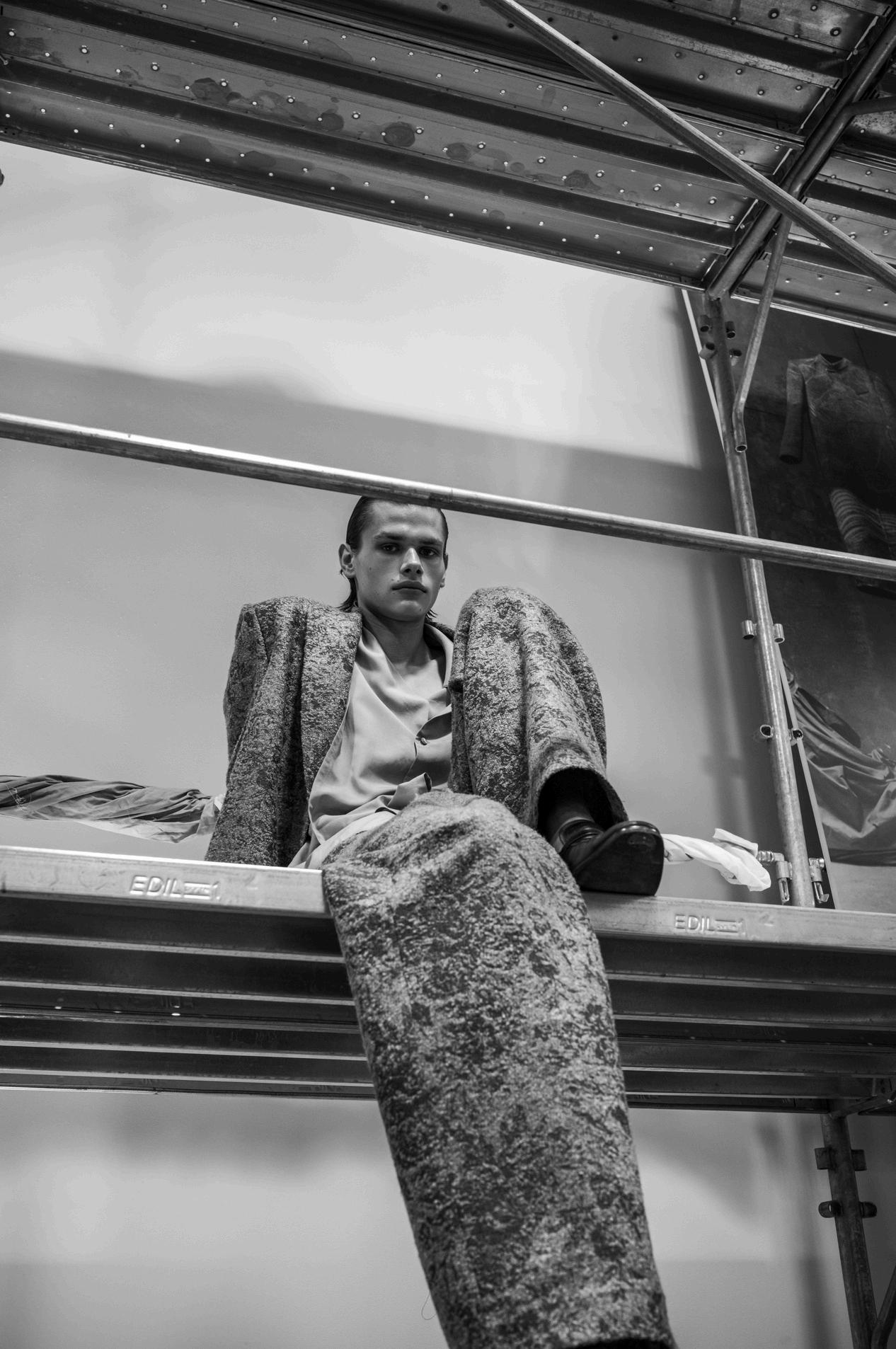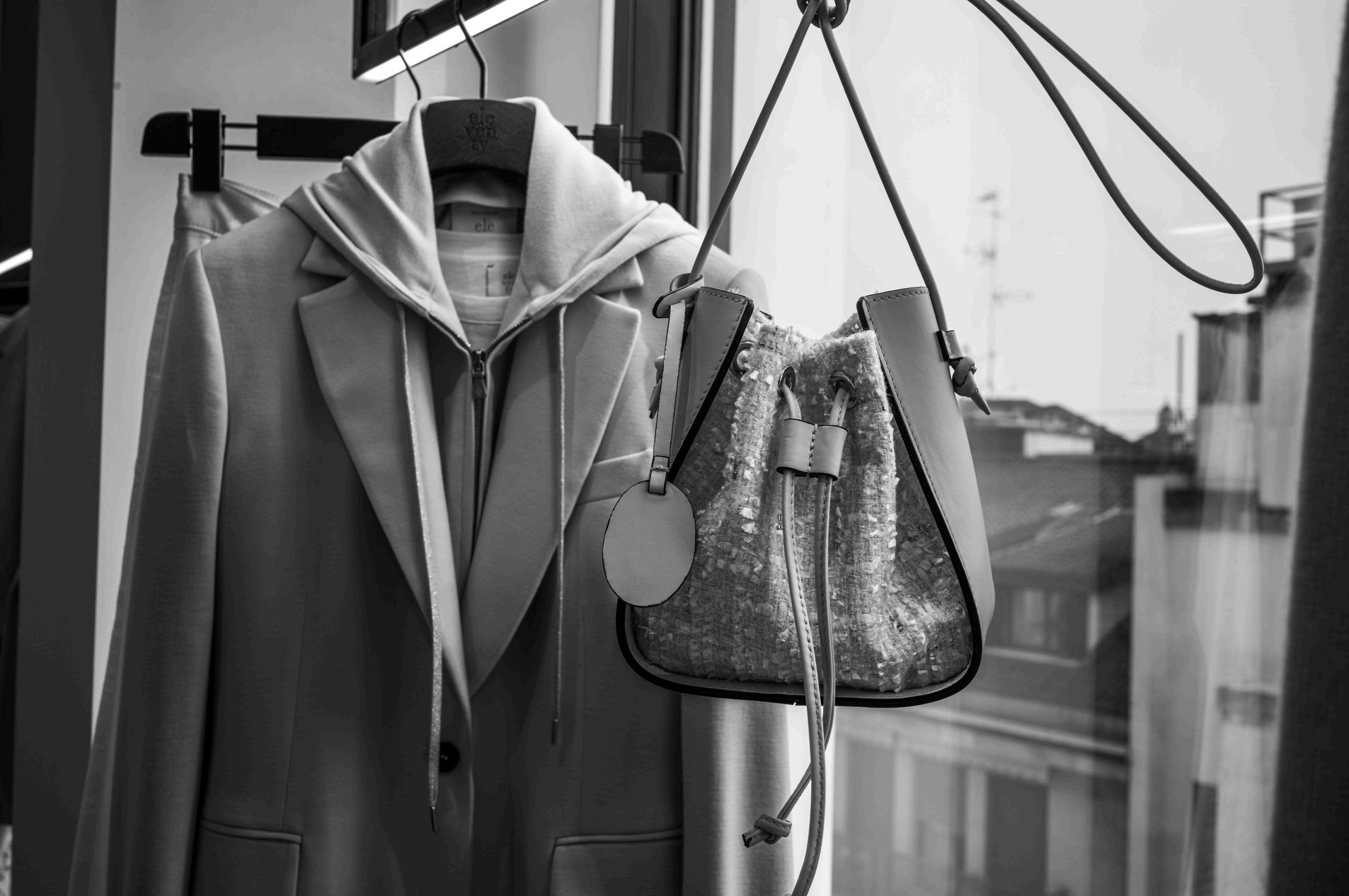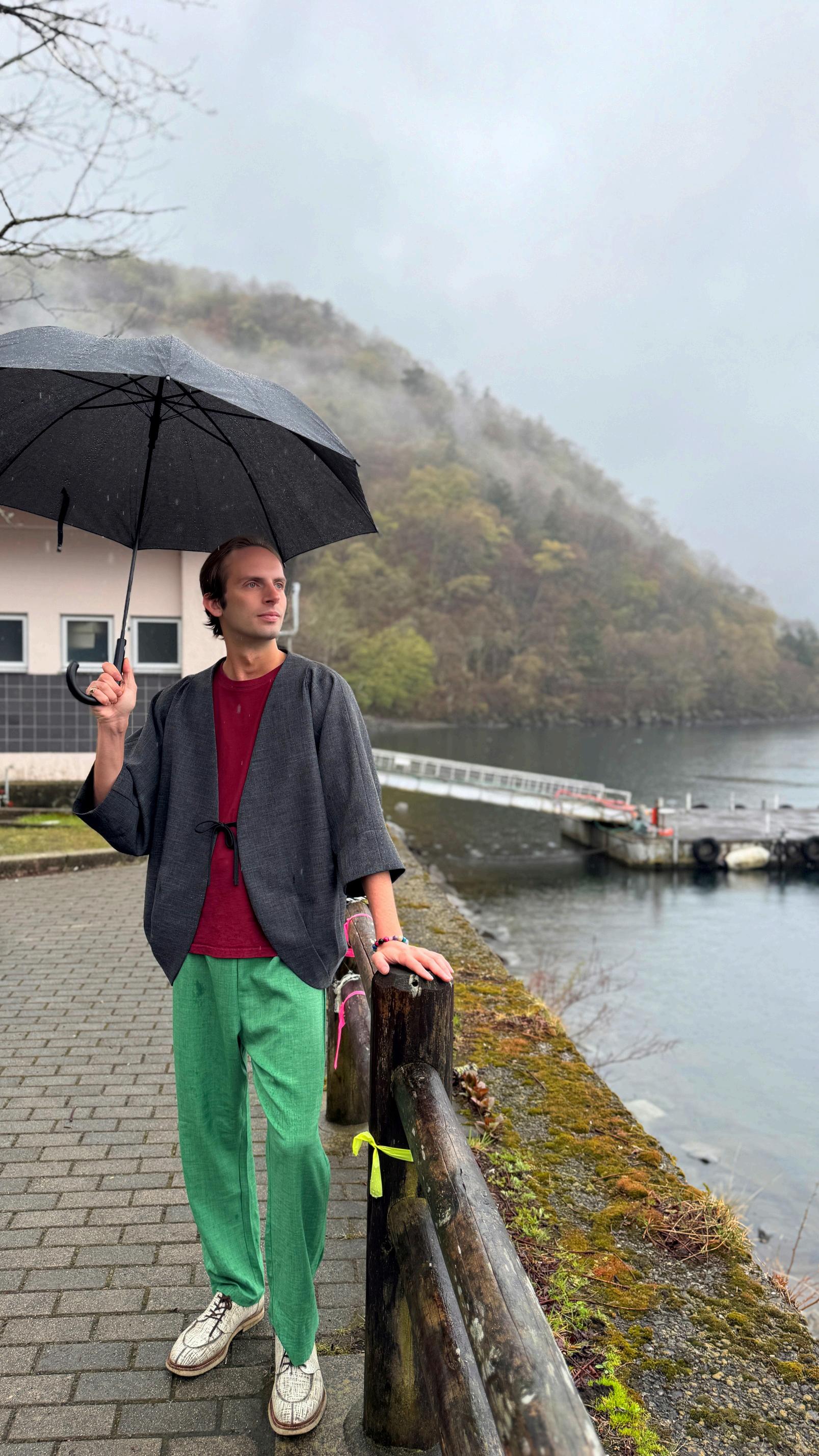YLetter from the Editor
ou don’t realize you ’ re in the moment until it’s a memory That was the theme of my summer 2025, which flew by in a whirlwind of dreamy beach days, adventures in the mountains, and magical evenings spent with my favourite people I blinked and it was over But, as I organize the chaotic piles of polaroids and unpack clothes which whisper of friendship, romance, and freedom, I know that it will never be forgotten
Fashion is experiencing the same type of moment The past six months have seen seismic change in the industry, with a number of major creative director departures and arrivals, and, perhaps more significantly, a major aesthetic shift towards the bold and unapologetically glamorous. Haider Ackermann’s debut for Tom Ford and Ludovic de Saint Sernin’s bacchanalia for Jean-Paul Gaultier Couture became moments to remember for a lifetime. And I have no doubt that historians will someday chronicle this year, and such shows, as the dawn of a grand new fashion cycle
In building the fall issue of Elysium, our team tried to preserve this moment in time as it happened - distilling its powerful emotions to be cherished both now and (like dusty polaroids) in the future
Photography director Leroy Velasquez leads us off by taking you all-access to Aniye Records, capturing chaos, adrenaline, and camaraderie backstage as stylists, models, and make-up artists alike prepared for one of the most iconic shows of the Fall/Winter 25/26 season. “There's something beautifully defiant about capturing rebellion in black and white,” Velasquez says. And the essence of that rebellion, as unapologetically Kate Moss-ian as smoking a cigarette on the runway, is eloquently portrayed through his exclusive photographs.
Later in these pages, you’ll discover the nuanced matryoshka-esque world of Numero Ventuno, which channeled Sofia Coppola for their latest Fall/Winter collection You’ll witness Antonio Marras lovingly bring a forgotten opera back to life on the runway, And you’ll discover how Loro Piana weaves an international and multigenerational narrative through the finest cashmere and silk Finally, we transport you to Japan for two moments of tranquility The RitzCarlton Nikko invites us on an exclusive tour of their serene mountain paradise and our guest contributor James Sullivan reflects on the rhythm of life from the Japanese Path of the Gods.
May this issue inspire both contemplation and renewed energy as the final breezes of summer fade. And may you find time to appreciate your own moments before they turn into memories.
Katheryna Shchurenko in look by Batakovic
Tokyo Confidential, Tokyo, Japan: A baseball-themed bar that blends American casual with Japanese cool, Tokyo Confidential is as serious about its mixology as it is playful about its menu The cocktail card for this season came in the form of a Manga book celebrating a “mysterious feline” who saves a group of shipwrecked travelers Within its pages is a diverse range of bold drinks to please all palettes Not all of the innovative concoctions are winners (a scotch/chardonnay/honey/mustard combination seemed incongruous even to my relentlessly adventurous palette) But most were at least an 8/10 in my ratings The bar’s gorgeous Tokyo Tower view and delightfully irreverent energy (the motto is “where elegance meets chaos” and a sign in the men ’ s washroom reads “ excess in moderation”) make it a destination to spend a full evening
The Order: Cheshire Cat Grin: calvados, gin, brown sugar, shochu, beetroot, champagne
Gold Bar at the Edition, Tokyo, Japan: Perhaps Tokyo’s most luxurious cocktail spot, appropriately nestled adjacent to one of its most fatally chic hotels, the Gold Bar at the Edition is the place to begin a Friday or Saturday night in the Japanese capital The scene is catnip for the global circuit’s young and beautiful, with towering ceilings framing dark wood banquettes and a DJ spinning afro house Service is excellent and the cocktail card is beautifully designed But the most memorable parts of an evening here are the drinks themselves Lovers of the classics are invited to try a local twist with the Quarter Martini (gin, vermouth, olive, sake abysse) or Grand Manhattan (sazerac, bourbon, sake, vermouth, grand mariner) Sweet rum-based cocktails also star: e g the yuzu agave colada with tequila, rose water, and mastiha
The Order: Adoninas Sour: Dry sherry, rose & sweet vermouth, orange liqueur, mango, dark rum, citrus
Sparrow, Chicago, USA: In a world full of tiki bars, Sparrow is a true unicorn Boasting hundreds of unique rums from around the world, and staff who are passionate about them, it’s a place to discover, neat, an underappreicated spirit
The Order: Holmes Cay Fiji 2004 17yr, El Dorado Port Mourant Cask Strength or 15 yr (Guyana)
The Bellwood, Tokyo, Japan: Ground zero for the cocktail game in bustling Shibuya (also home to such legendary spots as the SG Club), the Bellwood is home to the most technically precise and consistently well-executed cocktails I’ve had in Japan Headed by Atsushi Suzuki, formerly of Shanghai’s Speak Low, the bar is inspired by “kissa” cafe culture (which developed in 1910's Taisho-era Japan and involves a series of drinks being served with a kaiseki meal) Suzuki presents a masterclass in fat washes, infusions, and the synthesis of unexpected savoury flavours with classic cocktails For example, he offers an “Unusual Bellini” with sencha, sage, champagne, and peach foam, and the “Yakuniku Bloody” with smoked vodka, wagyu fat, yellow tomato, aged togarashi, and black garlic The wagyu fat-washed Bulleit bourbon, and all the cocktails mixed with it, were particularly memorable for me.
The Order: Genmai Mango Sazerac: genmai mugi, mango, sauternes, peat, absinthe
Bar Kohaku, Kyoto, Japan: Directly overlooking the Yasaka Pagoda from the beautifully appointed Park Hyatt rooftop, Bar Kohaku offers a series of exquisitely balanced locally inspired drinks Try the butter infused gin, the clarified shochu “bloodless mary ” or, for dessert, a chivas/matcha/plum wine/yuzu combination
The Order: The Last Samurai: Ron Zacapa, Pio Cesare Chinato, roasted tea, KI NO BAI (a plum/berry liqueur)
The Bellwood
H O T E L S & R E S O R T S
The Ritz-Carlton Nikko, Nikko, Japan: An oasis of tranquility located high in the mountains above the Japanese capital, the Ritz-Carlton Nikko offers a true cultural immersion experience combined with modern luxury From the expansive on-site onsen (Japanese hot springs) to the understated contemporary architecture to the lakeview rooms with floor-to-ceiling windows, every aspect of the property is curated to create soothing moments of restoration A full feature on the property can be found in this issue’s travel section
Intercontinental Doha the City, Doha, Qatar: Elysium consistently ranks Qatar Airways as the #1 airline in the world; conveniently, given how often we organize flights with them, Doha is one of the best layover cities imaginable This Intercontinental, my recent choice for a two-night stay, epitomizes everything I love about hospitality in the Qatari capital The staff smoothly accommodated a 7:00 AM checkin, an expansive rooftop pool and sauna area was available from dawn to dusk, and my well-appointed suite contained an exquisitely ergonomic bathtub overlooking commanding views of the city through floor-to-ceiling windows Central location to reach Doha’s various key spots
The Goring, London, England

Sarris Planet, Ermmoupoli, Greece: Sometimes the finest luxuries come in the form of warm hospitality, simplicity, and solitude Sarris Planet checks all of these boxes A 10room family-owned property located high in the mountains of Syros, both the capital and least-visited of the Cyclades islands, it offers the paradisiacal Greek getaway that we all dream of but, since the introduction of direct flights from the US in the 1990s, fewer and fewer have been able to attain The hotel is a true labour of love; the owner Dimitrios built it by himself and has managed it with his wife and son for the past two decades Dimitrios is, quite simply, the best host at a hotel or private apartment that I have ever had He personally chauffeurs all of his guests around the island at no charge, a massive help given both the hotel’s relatively remote location and the wealth of secluded towns, restaurants, and beaches (which Dimitrios is happy to recommend) in every direction Meanwhile, his wife ensures that every morning begins in fine fashion by preparing delectable and healthy homemade breakfasts Rooms have balconies with 180 views overlooking the island and Aegean Sea, perfect for an aperitivo. And as overtourism continues to haunt the Greek islands, silent sunrises here feel sacred


Intercontinental, Doha
Intercontinental Doha
March: Where You Are, John Summit, HAYLA: An anthem for spring break, summer, festival season, and most definitely ripping down a highway with the top down and your best friends in the back seat, Where You Are soundtracked Ultra Miami this year. Summit has arrived.
April: Roar, Charlotte de Witte: It’s safe to declare 2025 the year of techno queen Charlotte de Witte, who is releasing her first album on November 7 and became the first woman to both open and close Tomorrowland’s main stage this summer. This song is always a classic.
May: Heavy, Armin Van Buuren, JOA: Backed by the likes of Korolova, Anyma, and Agents of Time, 22-year-old Canadian JOA has exploded onto the scene in the last 12 months Heavy, his heaviest-hitting collab yet, might be the hardest and most under-appreciated drop of the summer “Talkin like they heard about me, they ain’t never seen one...apoc is a mean one, heavy like machine guns ” hits like few other hooks (think “b*tches love sosa”) have in years
June: Voices in my Head, Anyma, Argy, Son of Son: Anyma has also experienced a meteoric rise recently, with his revolutionary visuals (most famous from the Sphere Las Vegas but present at his shows around the world) only rivaled by his relentless stream of hits. For those who had three-month Mediterranean summers, with Monaco, Saint Tropez, Ibiza, and Bodrum nights blending together in a mix of magic and madness (sleep optional), this was the perfect soundtrack
July: Ma tnsani (yalla habibi), Vanco, AYA: You may draw a blank at “Vanco” or “AYA,” but you definitely know “ahlalela ahlalas ” Move over Move, Ma Tnsani is the song of 2025 and “ahlelala ahlalas” is a shockingly contagious and uncurable epidemic that has swept across the Med from Sass to Shellona to Scorpio’s As an Instagram meme mourning the end of summer says: “ we all need to ‘ahlalela ahlalas’ one more time.
August: Wait so Long, Swedish House Mafia, Agents of Time: Swedish House Mafia is back and better than ever This Agents of Time remix, which adds a dirty reverb to a sultry melodic track, is simply addictive Best enjoyed during exhilarating activities.
Best Live: For a Feeling, CamelPhat, ARTBAT, RHODES: From Ultra Miami, to Kappa Futura Torino to Zamna Cote d’Azur, ARTBAT had perhaps the best live performances we saw this season For a Feeling, a perfect sunset set closer, speaks to the soul
Rap Pick: FEIN, Travis Scott feat. Playboy Carti: FEIN, which can be considered for all intents and purposes as a sequel to “Sicko Mode,” was the one American rap track to make it onto European dance floors this summer It could be the beginning of an exciting new era for Travis, who showed up at clubs like Shellona Saint Tropez this summer Honorable mention here to Cloonee’s Stephanie (HNTR mix).
Russian Pick: ИЛЛЮЗИЯ, D.A.L.I., Timati: Speaking of new eras, Mr Black Star himself, now a DJ as well as a rapper, was back on the international circuit with a vengeance this summer He played or hosted parties with his Flava crew from Jimmyz to Verde Saint-Tropez to Mykonos to Bodrum to Ibiza, showing up with everyone from Keneimusik to Rick Ross. If it was “Black Star Summer,” this track, which describes the “Lifestyle” from Monaco to St Barth’s, is its theme song
Sunset Pick: Love’s a Game, Adriatique: This song and Back to Life, are perfect for segueing between dinner and a night of magical memories.
Workout Pick: Where I’m From, Cassian, Script, Belladonna: Perfect bpm for the sprint portion of HIIT trail runs (recommended with a beautiful Med view)

Maybe Someday, Colleen Hoover: Equal parts heart wrenching, heartwarming, and playfully intoxicating, Maybe Someday is the perfect beach read for anyone who wants to get lost in young love It tells the story of a college girl who moves in with her deaf next-door neighbor after finding out on their birthday (cue drumroll and melodrama) that her boyfriend was sleeping with her best friend. Her neighbor, as it turns out, is a brilliant musician, and a romance quickly sparks as she begins songwriting for him It all sounds like a fairy tale - the twist is that he has a girlfriend of his own, who is too sweet to hate and just happens to have a terminal illness This plot, I grant, could be incredibly corny if in the hands of the wrong author. However, Hoover, who makes each character relatable and likable, makes it a rollercoaster ride that’s impossible to put down and exquisitely captures the raw emotions of those age 20-25 years
Drunk: How we Slipped, Danced, and Stumbled Our Way to Civilization, Edward Slingerland: A serious sociological study written in riveting style, Drunk offers a nuanced and thorough examination of alcohol’s role in human society - both positive and negative - from primitive times to now Starting from the theory of natural selection, Slingerland asks why alcohol, which momentarily inhibits judgment in a manner that can threaten survival and can have long-term detrimental effects on families and communities, remains prevalent across the globe. His ultimate thesis, at the risk of over-simplifying, is that while alcohol has negative effects, intoxication in moderation has been critical to our development as a society Slingerland posits that when used socially, alcohol helps rationally selfinterested people build trust and camaraderie between each other, ultimately putting aside self-serving behavior for communal efforts that ultimately lead to further advancements for both the individual and the group He cites evidence that alcohol, and rituals surrounding it, coincide with or even predate our earliest societies (could it be that intoxication was as critical a factor as religion in bringing the settlers of Gobekli Tepe together)? He expresses concern for the future, underlining that alcohol’s positive effects on human history largely took place when only relatively low ABV beverages were available He considers the uses and drawbacks of other intoxicating substances And he also introduces readers to fundamental scientific theories that can underpin even everyday examinations of our pursuits of pleasure and progress This book reminds me of late-night philosophical conversations had with college classmates...in the best possible way.


The Vicious Circle, Katherine St. John: “A formal model inherits a magnificent wellness commune with a dark past ” If that’s not enough to peak your interest for a beach read, I don’t know what is In an age where cult scandals about, and so-called wellness movements often seem to coincide with dangerous practices and mass abuse, Katherine St. John’s page-turner is equal parts poignant, entertaining, and disturbing It’s distinctly modern, taking into account how the geopolitical events and new technologies of the past decade might converse with questions of leadership and control in a would-be cults And it has deeply sympathetic characters, many with complex backstories, caught up in seemingly doomed romances that one can’t help but cheer for. Waiting for this to become a Netflix special.
Tell Us No Secrets, Siena Sterling: Set at a prestigious East Coast boarding school, catnip for authors of the modern mystery, Tell us no Secrets delves into the world of intense young female friendships that sometimes can have devastating consequences. Sterling creates a friend group made up of a debutante jock, a beautiful it girl, an unpopular nerd, and a sophisticated rebel, then adds drama when friends are swapped, secrets are publicly spilled, and one girl ends up murdered This should also be a Netflix special
The Nazi Conspiracy: The Secret Plot to Kill Roosevelt, Churchill and Stalin, Brad Meltzer & Josh Mensch: Meltzer and Mensch take readers into a little-discussed theater of World War II: British-controlled Iran, which held a conference between the big three Allied leaders in November 1943 The conference was momentous for global history: it was here where an agreement about a “D-Day” strategy was finally reached after years of negotiation and where Roosevelt, Stalin, and Churchill established an invaluable level of personal trust across vastly different political and cultural lines Yet it almost never happened and, even worse, could have been derailed by a stunning assassination Tracing German, Soviet, and American documents, the authors explain how the Nazis quite accidentally built up a solid intelligence network in Iran (they airdropped two young SS officers, who were promptly forgotten about but went on to achieve astounding results, there at the start of the war) As a result, with rumors of the conference circulating, Germany put together an assassination plot that was ultimately foiled by the Soviets Meltzer & Mensch lean over-dramatic at times Nonetheless, this is a riveting and enlightening read which brings many little-known personalities of the war to life.


Les Années Folles de Coco Chanel, Villa Paloma, Monaco: A beautifully curated exhibition which tells Coco Chanel’s riveting story contextualized against a Côte d’Azur backdrop, the “Roaring Twenties” is the best show to grace the Nouveau Musée National de Monaco in years Few know that Coco had extensive Monaco/Riviera connections In 1914, she launched her second-ever boutique in MonteCarlo’s Hotel Hermitage less than four years after opening her iconic Rue Cambon location. She also made friends with the Monagesque royal family, with “it girl” Princess Charlotte wearing one of her designs for her wedidng to Count Pierre de Polignac in the early 1920's An avid sportswoman herself, Chanel appreciated Monaco’s dedication to female athletics (the first Women’s Olympics took place in the principality in 1921 and 1923) and frequently visited in her leisure time. In 1928, she decided to make it a permanent home, purchasing a large plot of land in Roquebrune-Cap-Martin (mere steps from the Monagesque border) and constructing the now-iconic Villa Pausa, where she would summer and host friends for 20 years (pictured middle left) It was once described by Vogue as “ one of the most enchanting that ever materialized on the shores of the Mediterranean,” and from the photos displayed in this exhibition, that is no understatement, Some of the most famous captures of Chanel, casually dressed in a marinière shirt, trousers, and an array of pearl necklaces, were taken at Villa Pausa
“Les Années Folles” is a tale of Monaco as well as Chanel, and even the most loyal Monagesques may discover something new about the principality here Meanwhile, a wide array of original Chanel designs, many over a hundred years old, and Ballets Russes costumes, will keep fashion lovers here for hours
Monaco and the Napoleon (s): Intertwined Destinies: Grimaldi Forum, Monaco: When Napoleon made his improbable return from the island of Elba to Golfe-Juan to launch his re-conquest of France, he almost immediately experienced an unexpected encounter with Prince Honoré, hereditary ruler of Monaco Honoré had lost his throne after the 1793 revolution; following the fall of the first French Empire, he was now en route home from Paris to reclaim it Taking this encounter as a starting point, this extravagant exhibition, including artistic treasures, royal jewelry, and historical artifacts such as Napoleon’s hat from the Battle of Waterloo, traces the relationship between the Napoleons and Grimaldis during the centuries It also serves as a beautifully-designed Monaco history lesson
Colours: Masterpieces from the Centre Pompidou: Grimaldi Forum, Monaco: An all-encompassing multisensory experience that unites, art, architecture, design, and fashion, this exhibition is a nuanced, soulful, and thoroughly researched exploration of the colours that comprise our world and how we have interpreted them throughout history Art anchors the exhibition: from black to white, pink to blue, yellow to red, paintings spanning eras and styles are arranged by colour and considered in the context of their respective cultural and historical contexts Marc Chagall, Mikhail Lariomov, Yves Klein, Vassily Kandinsky, Lucio Fontana, and René Magritte are just a few of the artists included But the journey does not stop there Different sensory experience rooms were created for each section, flooded with specially-designed perfumes and sounds and designed to fully immerse guests in the ethos of a specific colour Furthermore, different parts of a house (for example, “ garage ” or “bedroom”) were envisioned around singular colours, with furniture and design elements from the past century curated into a chromatically cohesive whole (Images: bottom left on page 10)

Monaco and the Napoleon(s)
Chanel by Marie Laurencin
Chanel in Deauville
Carrot Soup with Tuna Belly & Argan Oil, Sketch, London, UK: This amuse-bouche, along with the oyster ice cream, were both mind-bending flavour combinations and the highlights of my three Michelin-starred meal at Sketch
Bottarga with White Chocolate, Iodio, Athens: This unexpected and decadent indulgence, enhanced by creamy butter and fresh-from-the-oven bread, is the only way to start a meal at one of Kolonaki’s trendiest restaurants Follow it up with the sea urchin orecchiette
Melon, Watermelon, & Mozzarella: La Môme Riviera, Roquebrune-Cap-Martin, France: A new project in collaboration with the Maybourne Riviera, this Insta-perfect La Môme checks all the “seaside lunch” boxes with this colourful dish served in a melon
Humboldt Squid, Bar Chouette, Calgary, Canada: Served with gochujang glaze and yuzu aioli, this succulent squid brings Korean and tropical twists to one of Canada’s favorite products Ideal as a “slutty” starter to share
Pâté en Croute: Lature, Tokyo, Japan: Japanese game is the theme at Lature, which serves French-inspired cuisine h on a quiet Tokyo side street Chef Takuto Murota often hunts your food himself, and the venison blood macaron, served as an amuse-bouche, is his signature. Murota’s take on pâté en croute, always one of my favorite dishes, contained venison, bear, and badger
Kare-Kare, Kasama, Chicago, Illinois: This Michelinstarred Filipino gem, hidden on a residential street, serves as both a tasting menu dinner destination and a casual cafe/bakery. Their kare-kare (a Filipino meatloaf served with peanut sauce, shrimp paste chili crisps, and garlic rice) is perfect for lunch (with matcha) during a busy work day
Thin Blue Fishes Escabeche Style, Le Cap, Saint Jean Cap-Ferrat, France: Served with seaweed and XO sauce, this dish blends the fresh flavours of the Côte d’Azur (sardines and mackerel) with touches of sweetness, citrus, and caviar
Grilled Spiny Pink Lobster, Le Cap, Saint Jean CapFerrat, France: Le Cap followed up the carpaccio with an even more memorable course: lobster grilled Japanese style then served with cantaloupe, tomato, and a smoky sauce
Ravioli Finanziera, Ristorante Consorzio, Torino, Italy: Stuffed with giblets, brains, spinal marrow, rooster combs, sweetbreads, and porcinis, this Piedmontese specialty pasta does not appeal to everyone But even for my less adventurous friend, it was love at first bite
Lobster & Caviar Sando: Arnaud Donckele & Maxime Frederic at White 1921, Saint Tropez, France: Afternoon tea at this pop-up was a must this summer, and amidst a series of delectable pastries, this was the star
Tableside Tartare de Boeuf, Quai des Artistes, MonteCarlo, Monaco: Port standby Quai des Artistes, long the final word in Monagesque bistros, has received a muchneeded modern facelift courtesy of new Owner Bertrand Letartre That extended to the menu as well as the space; the beef tartare is made tableside with both scientific precision and artistic flare
Chaufa Rice with Octopus, Coya, Monte-Carlo, Monaco: The most popular dish among my “Monaco family” this summer, this slightly sweet, slightly spicy rice blended Peruvian and Portuguese flavours with perfeclty cooked octopus and a touch of soy
Pesto Trofie: La Spiaggia, Eze, France: Ordering a pesto trofie outside of the Ligurian Riviera might seem sinful, but this on La Spiaggia is just twenty kilometers away, we’ll give you a pass This is made the proper Portofino way, and you can spice to your liking from the chili pepper plants growing at each table
Wagyu Beef Tenderloin, Yasaka, Kyoto, Japan: The destination for my most recent birthday dinner, Yasaka delivered one of the best wagyu experiences I’ve ever had Lightly seared to melt-in-your-mouth perfection
Lamb Laal Maas, Jamawar, Doha, Qatar: An offshoot of an iconic London restaurant, Michelin-starred Jamawar serves the best Indian food I’ve had on the Gulf (and that’s saying a lot). The exquisitely spicy lamb laal maas is best enjoyed in a lunch set
Strawberries & Cream, Florilege, Tokyo, Japan; One of the simplest desserts of the season proved to be the best These divine strawberries alone were enough to understand why Japanese chefs emphasize ingredients so quickly
Lobster & Caviar Sando La Spiaggia
D e s t i n a t i o n o f t h e S e a s o n :
S y r o s , G r e e c e
W a n t y o u r f a v o u r i t e d e s t i n a t i o n , s o n g , o r b o o k o n t h e
E l y s i u m H o t L i s t ? K n o w
a n y w h e r e w e s h o u l d h e a r a b o u t ?
C o n n e c t w i t h u s o n I n s t a g r a m
a t @ w o r l d o f e l y s i u m
O r g e t i n t o u c h a t
e l y s i u m c o c k t a i l c l u b @ g m a i l . c o m
Y o u c o u l d b e f e a t u r e d i n t h e n e x t e d i t i o n o f E l y s i u m m a g a z i n e !
A N I Y E R E C O R D S
A L L - A C C E S S W I T H T H E
S E A S O N ’ S M O S T
I C O N I C S H O W
“There's something beautifully defiant about capturing rebellion in black and white. It strips away everything but the pure emotion of the moment."
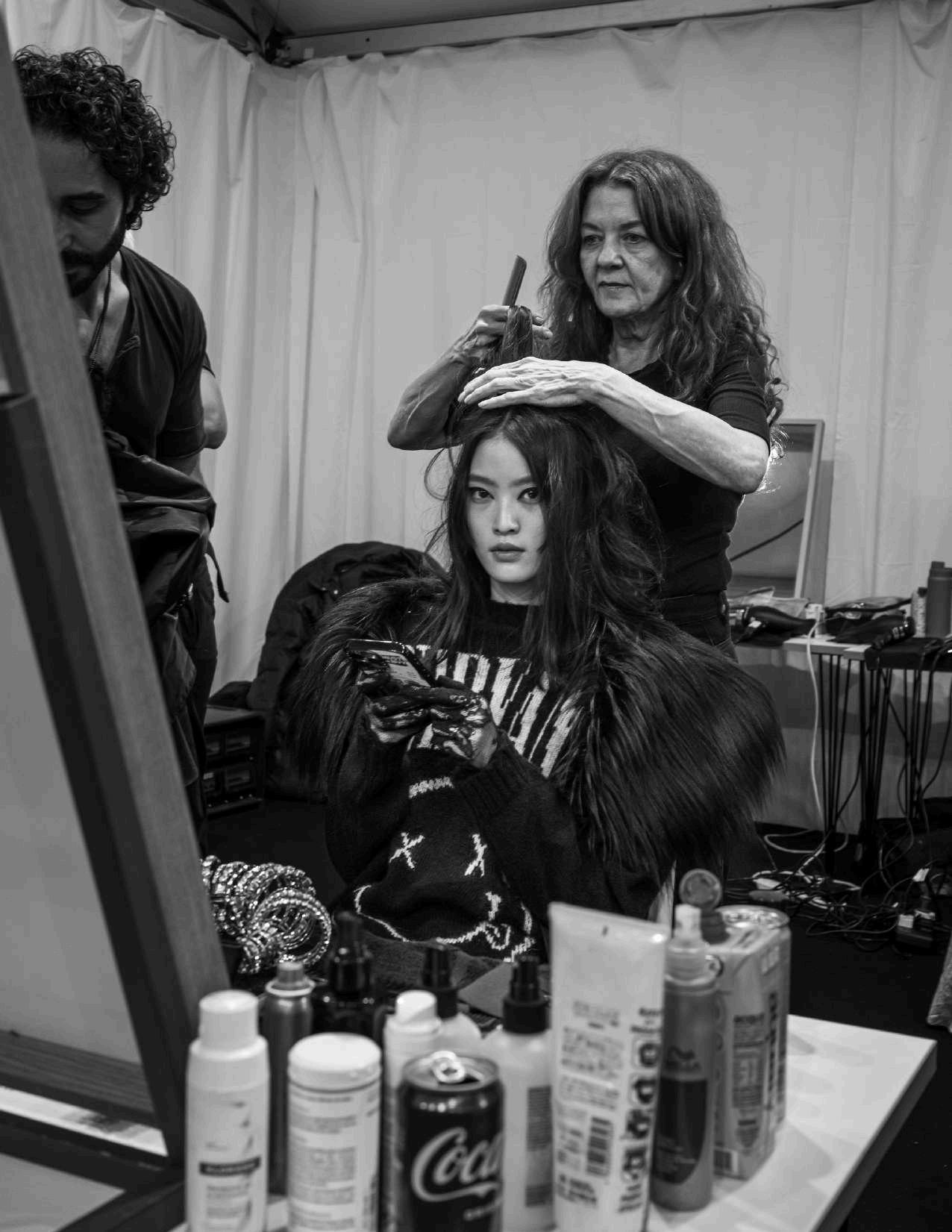
When I reflect back on my first years following the fashion industry, the halcyon days of the 2000’s and early 2010’s, Kate Moss casually smoking a cigarette as she strutted down the catwalk to close Louis Vuitton’s F/W 2011 show is one of the undisputed highlights. The moment was remarkable for many reasons. First of all, it was highly unexpected; Moss had officially retired from the runway in 2004 and only walked twice since Secondly, it was rebellious in the uniquely “too cool to care” way that Moss epitomizes better than anyone At a time when fashion and the highflying lifestyle surrounding it was becoming disturbingly de-fanged, Moss’s “transgression,” languorously performed before a guest list nibbling caviar canapes and slamming 10 a.m. vodka shots served by waitresses in French maid uniforms, was a delightfully sinful statement. The consummate Femme Fatale, with a little grunge and a lot of glam, Moss reminded us that the supermodel era, and the dark yet empowering hedonism that defined it, was far from over
Going into the Fall/Winter 25/26 season, it could be argued that fashion was more de-fanged than ever before. Yet, thanks to a fashion month that saw Haider Ackermann revitalize Tom Ford, Ludovic de Saint Sernin capture a gloriously violent euphoria for Jean Paul Gaultier Couture, Maria Grazia Chiuri bring touches of leather and grunge to Dior, and fur multiply on the runways by an astounding 400+%, the trend was about to seismically shift Alessandra Marchi’s Aniye Records stepped into the spotlight and delivered the singular signature moment that epitomized this shift better than anyone
“That perfect contradictioninnocent yet dangerous
My eyes are drawn to moments where tradition meets transgression”
“The way light catches in fur, gets lost in those layers... that's where the real story lives
In the clothes and the spaces between them ”
Unsurprisingly, smoking, the ultimate symbol of youthful rebellion, was involved
In further contextualizing Aniye Records’ F/W 25/26 show, it’s important to note that a controversial law banning “smoking in all public spaces, including streets,” was effected in Italy’s fashion capital on January 1, 2025. Anyone who’s attended a Milan Fashion Week knows that smoking is, for better or worse, an nearindispensable part of the city’s fashion and nightlife scene. It is outside the smoke-wreathed entrances of clubs, cocktail parties, and presentations, cigarettes or vapes in hand, that friendships are formed, romances are sparked, and connections that change careers are made Much like a happy hour in the US or a champagne brunch in Dubai, it is here where the personal and professional combine in a locus of social life where anything is possible. While theory differs from practice, and the demise of smoking in Milan seems to have been highly over-exaggerated, there was still much trepidation about the law from the fashion crowd. Fittingly, Aniye Records, finger firmly and unfailingly on the pulse of the young, beautiful, and rebellious, responded with perhaps the most poignant and iconic moment in the brand’s young history
The second model to swagger down the runway for F/W 25/26 captured several elements of the signature Aniye aesthetic; she wore a slinky lingeriestyle slip accentuated by statement jewelry and beribboned lace stockings recalling the ballet. Stone-faced, with an expression ranging between exasperation and boredom, she inhaled from an E-cigarette mid-stride.
“There's no pretense in a warehouse at 4:00 AM That honesty, that exhausted beauty - that's what I was chasing in every frame.”
Subverting the innocent into the seductive and presenting a bold symbol of self-empowerment through exquisite insurrection, Marchi celebrated the new revolution of a new generation.
This second look was only the beginning. The fourth model, also smoking, wore an intricately crafted lace dress with a nostalgic headscarf that seemed to reference traditional bridal looks Yet a dramatic leather coat completed the ensemble, adding a distinctive urban edge with an irreverent (and very Kate Moss-like) smirk Marchi’s protagonist is a girl who holds all the cards: uncontrollable yet in control, she likes to toy with the world on a string and laugh at the results. And she is very much a daughter of that glorious early-2000’s era that immediately predated the advent of cell phones. Marchi united turn-of-the-century glamour with contemporary couture sensibility, proposing oversized fur coats, paired with complex layers, in ivory, leopard print and black She also used fur for ingenious accents, such as exaggerated epaulettes expanding like the wings of an angel or oversized cuffs adding a playful touch to an elegant pink gown
Aniye Records has always had a rockstar soul. Need proof? Just look at the S/S 25 spectacle that saw guests become paparazzi beside a black carpet runway or the F/W 24/25 “Dark Date” show soundtracked by Justice & Simian’s “We Are Your Friends.” Marchi made the association even more explicit this season, proposing iconic Nirvana, Blondie, and Iron Maiden motifs on oversized T-shirts and sweaters
Yet she also embraced the modern techno code and its loyal followers (dressed, of course, in head-to-toe black). Striking leather hats carried a distinctive Berlin edge. One look saw black sheer and lace paired with a leather corset, snakeskin bag, and unexpected tartan skirt.
This was elevated grunge, catnip for the quintessential cool girl Her signatures are tousled hair, eternally smudged eyeliner, and distressed clothes - not in the curated style that so many seek to replicate but isntead because she is supremely self-assured and utterly unbothered She spends all night in a warehouse dancing to Charlotte de Witte’s driving acid techno, then returns, looking inexplicably fresh, to crushing her career the next day. And at 5 a.m. she can often be found in those aforementioned smoking areas, leaning on a wall outside the most exclusive clubs in Europe, painfully bored with a life that most romanticize
Marchi, with her intoxicating defiance and technical refinement, is quickly becoming the final word in fashion for the Milanese “It Girl ” Designing for those who shape the rhythm of the future while embracing the rhythm of the night, she is the latest iteration of a Moss-ian spirit that refuses to bow to societal pressure. Her Fall/Winter 25/26 show was unadulterated and unapologetic fun for rebels with a cause - and an iconic moment that will symbolize a watershed fashion flashpoint for years to come.
“Every moment I captured was a love letter to the rebels who refuse to be tamed.”
Numero Ventuno founder and creative director Alessandro Dell’Acqua channeled Sofia Coppola for an intellectual and introspective collection to open Milan Fashion Week F/W 25/26. Dell’Acqua’s house took center stage on the first day of the calendar, a nod to its revered niche within the city’s scene, and the soft-spoken designer delivered with a series of sophisticated ensembles that revealed new layers of nuance upon each examination Beautifully distilling his particular brand of unapologetic urban chic into a cohesive narrative, Dell’Acqua epitomized the nostalgic angst of “finding oneself” so prevalent in Coppola’s films while celebrating women who seize their own destinies.
Like any compelling story, the collection unfolded deliberately but with unexpected twists. Dell’Acqua opened the show with a series of timeless and sleekly tailored looks dominated by a black colour palette Ranging from a substantive wool overcoat to an exquisite little black dress and a quasi-transparent caftanreminiscence piece given structure by a statement belt, they covered a broad range of Dell’Acqua’s beloved sartorial vocabulary and offered a versatile wardrobe for those evermercurial months marking the transition between fall and winter.
The collection was strongest when playing with layering. An oversized double-breasted trench coat drew a stark contrast with the elaborate roaring-twenties style feathered skirt it was ingeniously paired with This was not the only appearance of a feathered skirt
Most notably, one contrasted an elegant grey blazer with a deep vneck shirt, bringing together business-like sensibility with nonchalant urban cool and a touch of glam. And a vivid red cardigan-style sweater juxtaposed a floral-patterned white skirt for an injection of playful femininity that further diversified the collection
For those familiar with Coppola’s films (or who were inspired to rewatch them after attending the show), the references were ever Florals captured the sensuality of Marie-Antoinette The oversized sweaters paid homage to the quirky and paradoxically self-assured charm of Lost in Translation’s awkward yet endearing protagonist as she navigates the foreign streets of Tokyo, Japan. Finally, preppy silhouettes and omnipresent bows spoke to the nostalgic and tragic Americana of The Virgin Suicides, in which suburbia may be more disturbing than it first appears
Overcoats starred A furry brown duffel, effortlessly elegant, elicited murmurs of approval as it swept down the runway and stands in retrospect as one of the most covetous pieces of the entire season. A casually draped custard yellow overcoat, one of the last looks to appear, provided a pop of pastel. Meanwhile, a long grey coat, worn with a popped collar and adorned with flirtatiously haphazard black feathers, exquisitely captured the urban carefree edge of the collection Is its wearer returning home after a long night or heading to a meeting at which she will accidentally be the best dressed? The answer might be both
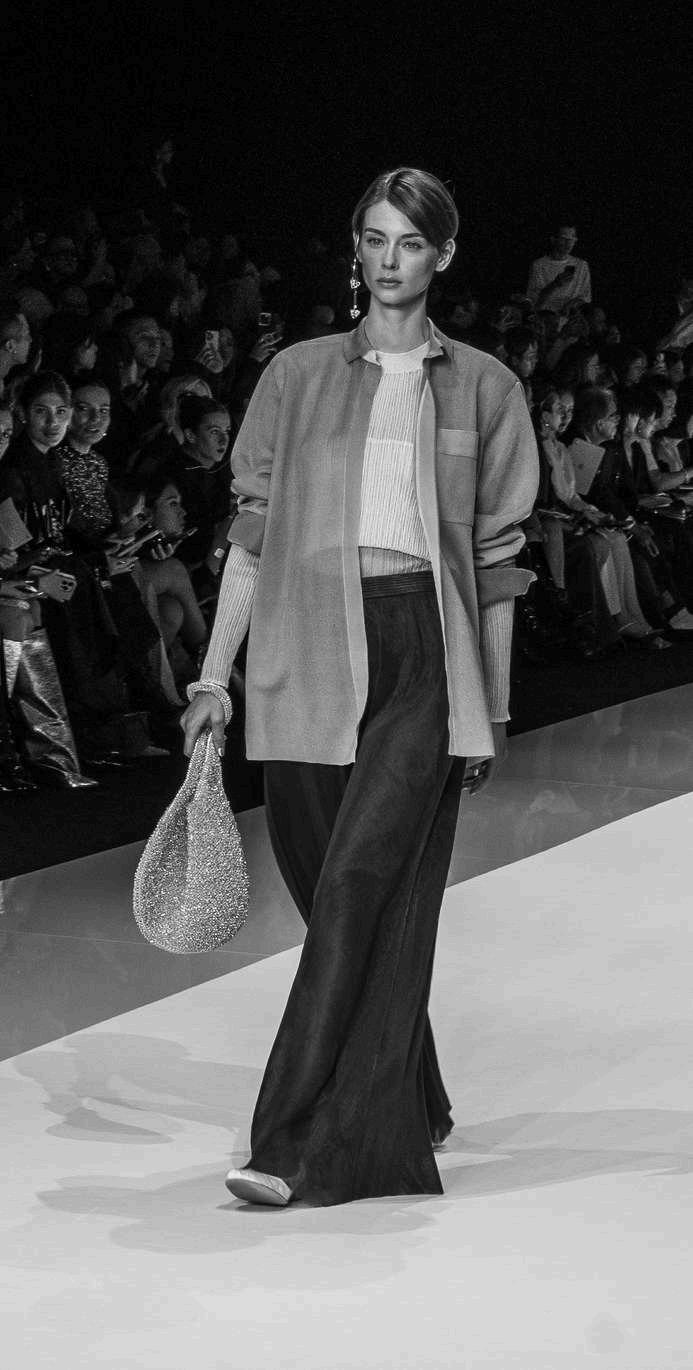
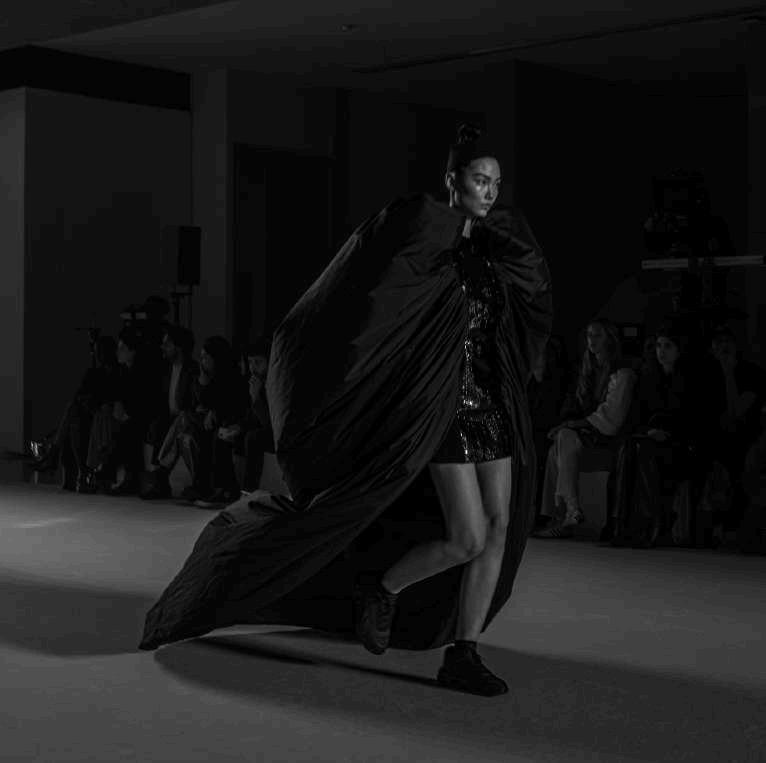
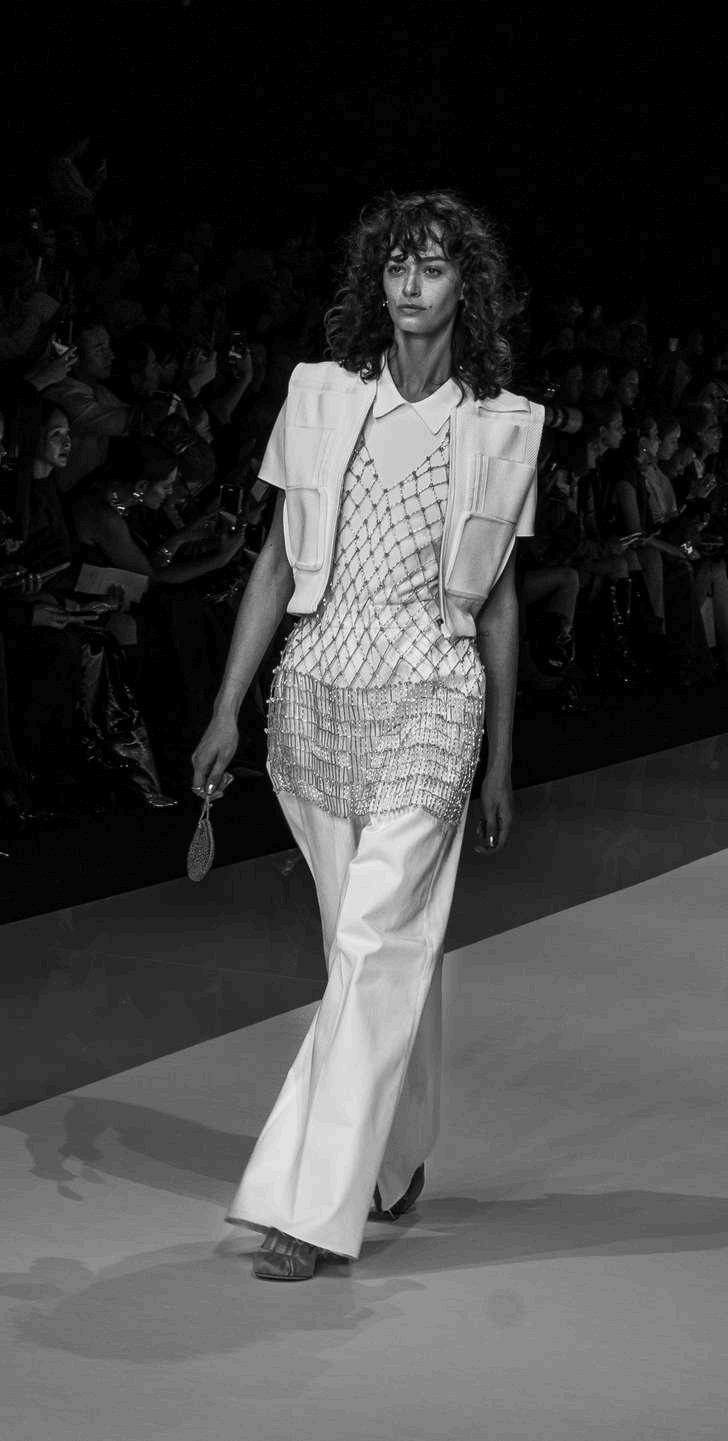
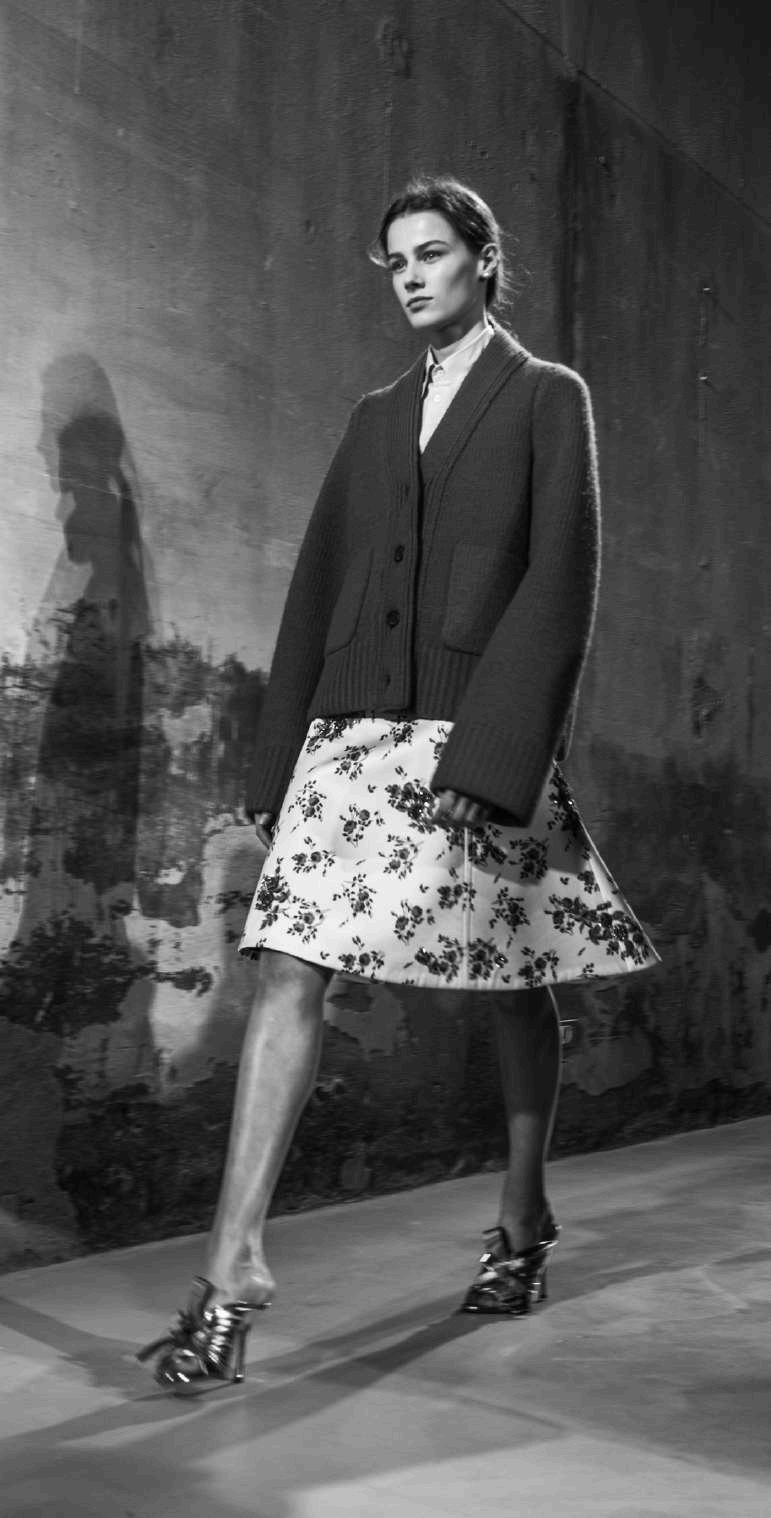
Referring back to Coppola, one of the most iconic scenes in Lost in Translation comes when Bill Murray, effectively playing himself, is in a Tokyo studio filming a commercial for the Japanese whiskey Suntory. The high-strung Japanese production crew fires off an interminable series of instructions in their native language, yet when Murray repeatedly asks for an English translation, he is only told “Look at the camera with intensity ” Reviewing this collection, I felt somewhat like Murray’s character filming the perfect take of the Suntory commercial in a good way Not all was apparent at first glance, and the devil was in the details But, as Murray discovers about Japanese culture in Lost in Translation, the riddle is worth solving. Dell’Acqua is both a scientist and artist, intentionally considering each aspect of a look but doing so with an alluring creative flair and “too cool to care” attitude.
Lost in Translation, while also a journey of cultural discovery, centers around an illicit “will-they-or-won’t-they” May/December romance between Murray and a young Scarlett Johansson’s Charlotte (both married) After many lost opportunities, the film concludes with a much-anticipated kiss amidst the busy streets of Tokyo moments before Murray hops in a taxi to return home to America and his wife. The moment provides the audience and characters with a much-needed moment of release but also leaves them wistful for more. I reflected on this Numero Ventuno show with the same feeling - satisfied by an ambitious and smoothly executed collection but yearning for the sartorial story to continue. As Dell’Acqua’s star continues to consistently rise, I’ve already circled his next show on my calendar as one of the most-anticipated of the Spring/Summer 26 season
R U N W A Y
WORDS: Jenifer Nelly
Photos provided by house
When history whispers, Antonio Marras listens… and for Autumn/Winter 2025, he turned up the volume. Born in Alghero, on the island of Sardinia, Marras draws deeply from his homeland’s layered heritage. The designer unearthed a forgotten operatic gem, La Bella d’Alghero, a melodrama from 1892 that was set in his hometown city and had been performed only once - in Pesaro Marras then wove it into the emotional and conceptual heart of his latest collection in a way that only he could, letting the opera's spirit pulse through every stitch.
The Opera That Woke the Wardrobe:
The rediscovery of La Bella d’Alghero - with music by Giovanni Fara Musio and libretto by Antonio Boschinisparked a journey through Sardinian and Catalan heritage, cinematic surrealism, and the romanticism of bygone eras Marras imagined a troupe of actors arriving from Barcelona to breathe opera back into the stage, and dressed them accordingly: sensual silhouettes, tiered pencil skirts, embroidered brassieres, and tailored jackets in shadowy blacks.
The show unfolded in a bare industrial space, allowing the garments to speak for themselves.
And speak they did - of longing, of memory, of theatricality. The collection opened with a procession of black looks, never flat or lifeless. Sequins shimmered like candlelight on velvet, and textures were layered like verses in a libretto, each one aching with emotion.
With fabrics as drama, the collection unfolded as a tactile symphony: Prince-of-Wales checks, brocade, damask, Ottoman jacquard, leather, denim, velour, silk, satin and tulle Marras embraced both fine details and maximalism, layering textiles and techniques such as appliqués, embroidery, patchwork, and pleating to create garments that feel like living canvases. Column gowns became canvases for brushstrokes and sketches. Chiffon pieces floated like ghosts of forgotten arias. The looks didn’t just reference the longforgotten opera they embodied it and pulled it into the 21st century.
The collection featured both menswear and womenswear On the mens side, elegance met structure as romantic florals bloomed across bomber jackets and casual trousers Meanwhile, patchwork tailoring mixed pinstripes, herringbone, and decorative brocade, echoing the opera’s fragmented history and Marras’ enduring passion for storytelling through fabric. True to his roots as a visual artist, Marras handpainted garments with roses, hands, musical notes, and ciumpulls - quirky, accidental touches that add character, emotion, and authenticity to a piece Rather than correcting or concealing them, Marras embraces these poetic imperfections as part of the garment’s story
These motifs weren’t just decorative; they were declarations As Marras himself said, “I am passionate about giving a voice to seemingly mute things so that they become garments that speak ”
Similarly, roses wrapped around the models’ shoulders were as much symbols as they were decorations. Marras has long used roses as a motif to express passion, drama, and romanticism. In this collection, the rose becomes a visual metaphor for the emotional intensity of the La Bella d’Algehero, alive with all the passion of the opera’s protagonists
Even the models’ makeup echoed the opera’s romantic spirit Glossy eyes, and red and gold leaf lips, highlighted with touches of shimmer courtesy of KIKO Milano brought theatrical warmth to the models’ faces that felt at once both timeless and modern. The show was also notable for the predominance of tight, elegant braided hair, often styled close to the scalp or woven into sculptural shapes. The braiding added a historical and folkloric touch, echoing the Sardinian and Catalan traditions that inspired the collection Antonio Marras is a master of contrast; the hair and makeup acted as a grounding force to clothes so rich with texture and symbolism The braids evoke tradition and strength, while the soft makeup lets the clothing “speak,” as Marras himself puts it.
Marras hinted at plans to restage La Bella d’Alghero in an opera house instead of just bringing it to a runway. Sara Stone, who the designer has praised for her authenticity and artistry, has ben linked to such a project.
The pair already share sketches & ideas, and, like a duet waiting to be sung, it’s a collaboration that feels inevitable But regardless of what happens in the future, this was a massive triumph for Marras Autumn/Winter 25 wasn’t a mere fashion show but a resurrection, tribute, and beautifully melodramatic moment stitched in silk and sequins. Marras didn’t just design clothes he composed a visual opera, and every look was a note in its score.
Antonio Marras Resort 2026: A Poetic Reunion in Alghero
Mere months later, Marras crafted another lyrical sartorial tale with his Resort 2026 collection, reimagining a nostalgic voyage where La Bella d’Alghero’s Consuelo - muse, artist, and wife of Saint-Exupéry lands in Sardinia. This is no spectacle; it’s a confession…a tender tribute to imperfection, longing, and the idea that fashion, at its most powerful, is both visual and visceral. Each look unfolded like a diary page from a love story lost in time, rediscovered through fabric and form.
Masculine–Feminine Fusion: Rugged aviator jackets and utilitarian parkas were softened with floral embroidery and corsetry a duet of strength and vulnerability
Patchwork as Memory: Marras’s stitched leather, lace, denim, brocade, pinstripes, and florals into an emotional fabric mosaic.
Volume Play: From structured bodices to sweeping trousers, silhouettes swing between drama and intimacy.
Botanical Storytelling: Golden florals and burgundy jacquards evoke Sardinia’s raw beauty, blooming like memories recalled in flashes
Sketches & Embroidery: Marras’s own drawings of Alghero appear as embroidered whispers wearable postcards half real, half imagined. Meanwhile, the oversized sweaters feature bold, painterly designs of buildings and domes, turning each garment into a wearable canvas.
The collection echoes Sardinia’s seaside magic: baby blue retro dresses, burgundy blooms, and sketch-covered poplins that hum with nostalgic warmth Marras layers washed denim, caramel leather, and antique lace to capture both terrain and temperament while synthesizing the rugged and romantic sensibilities that form Sardinia’s dichotomy. The denim pieces perhaps best exemplified this paradigm; they were a fusion of workwear and poetry that was grounded yet imaginative. Another personal highlight was a cropped jacket with floral embroidery and checkered touches paired with wide-legged trousers and an olive structured handbag - military precision met bucolic softness
Consuelo lingered in every stitch not as biography, but as myth She floated through the collection as a poetic archetype: wistful, wild, and beautifully fractured. As with his autumn/winter 25/26 collection, Marras wasn’t just designing garments; he was shaping memories, building myths, and conjuring magic. This is more than a seasonal offering; it’s a sensorial voyage into Marras’s Sardinian soul.
E L I S A B E T T A F R A N C H I
WORDS: JESSE SCOTT
PHOTOS PROVIDED BY HOUSE
Within the labyrinthine halls of the lavish 17th century Palazzo Acerbi, Elisabetta Franchi’s F/W 25/26 show brought the swaggering silhouettes and unapologetic opulence of 1990’s fashion back to life for the modern woman Franchi told the assembled press “this collection is a tribute to the strength and freedom of women who are unafraid to express themselves, who embrace their sensuality with confidence and determination ”
Feminine while firm, structured while seductive, and unfailingly elegant, the collection centered on the narrative from one of fashion’s golden eras while developing nuanced interpretations of its silhouettes distinctly suited for 2025. By synthesizing timeless with contemporary, Franchi curated a balanced vision that many designers strove for but few executed as effectively this season The concise 45-look collection unfolded with purpose and poise, revealing a full wardrobe for versatile women whose clothes compliment and highlight their natural charisma.
The interplay of textures and aesthetics which dominated the show was evident from the first look. A graceful long black topcoat, notable for gold button accents which introduced a key chromatic theme, was worn open with a bra and leather gloves to suggest a ferocious femme fatale
Another coat combined a chiseled leather corset with a voluminous furry collar and sleeves, while a third (which injected a rich shade of burgundy into a sea of black ensembles) found cohesion in the contrast between elegantly draped wool layers and statement leather boots and gloves. Franchi excelled most this season when working with crocodile. A long croc trench, worn over a white turtleneck by a blonde model with dramatic mascaraed eyes, screamed Bond villain. Meanwhile, a sharply cut short croc jacket, worn with a matching skirt, channeled the same magic that Daniel Roseberry has for Schiaparelli
This was not the only Roseberry comparison one could make To say that Franchi is Italy’s Schiaparelli would be an overstatement but the visionary Bologna-based designer has nonetheless tapped into the same sartorial undercurrents with which Roseberry has recently revolutionized the industry. Denim was employed sparingly, surprisingly, and effectively.
Look 11, which combined a simple black tank top with straight-leg jeans and trompe l’oeil details, was in many ways a more complex if less groundbreaking version of the ensemble that Kendall Jenner famously wore down the runway for Schiparelli in Spring/Summer 2025
Meanwhile, the signature belt, strategically placed zipper, and playful golden horseshoe details on Look 6 hinted at the sly surrealist sensibility that has become a Roseberry calling card.
The Franchi show has long been a highlight on the fashion calendar for a who’s who of Milanese society This season was no different, as the designer demonstrated her innovative spirit, opened a nuanced conversation with history using a sophisticated sartorial vocabulary, and kept her finger firmly on the pulse of a clientele that appreciates timeless luxury but remains focused on the future. Franchi said: “I wanted to bring to life a femininity that is both elegant and disciplined, assertive yet provocative, Every piece tells the story of a woman who challenges conventions with grace, never compromising her own power.” Franchi’s heroines are simply formidable.
R U N W A Y
L U I S A B E C C A R I A
Luisa Beccaria Fall/Winter 2025 was all about patterns. The ageless designer epitomized youthful elegance by reimagining playful polka dots in a sophisticated and fresh take on winter dressing. Spreading brightness into the darker, colder months, Beccaria used the classic if whimsical motif as a symbol of optimism during short winter days She also continued to demonstrate her enduring love for florals, which this season emerged in delicate prints and embroidered lace to bring a breath of romance to heavier seasonal fabrics
The collection was also defined by textural richness. Beccaria has long understood that fabric can carry as much narrative as color or cut, and Fall/Winter 2025 was a masterclass in layering tactile sensations. Soft chiffons, printed organza, and delicate lace floated down the Casa Cipriani runway, evoking femininity in its most ethereal sense Yet they were paired with mohair knits, tweeds, and even corduroy, grounding ephemerality with cozy structure Velvet, sequins, and tulle added dimension, while macramé lace and stretch taffeta provided architectural balance. Florals did not seem out of place even when paired with tweed or corduroy, instead reminding us of the designer’s carefully curated vision.
This same spirit is reflected in Beccaria’s color choices. Yes, there are the luminous polka dots, but they were surrounded by rich shades of burgundy, chestnut, deep chocolate
Together, they paint a canvas of garments that are soft yet strong, and dreamy yet wearable, a portrait of modern femininity.
Luisa Beccaria’s vision has long resonated beyond the runway, with many celebrities embracing her romantic aesthetic. Sarah Jessica Parker has been seen in one of her polka dot dresses, Madonna dazzled in a pleated floral satin gown from Fall/Winter 2022, and Lady Gabriella Windsor is also a supporter of the brand Their discerning choices underline what Beccaria represents: clothes that are feminine, striking, but always timeless. The designer’s venue choices echo the paradigm; guests were transported to picturesque restaurant LuBar for Spring/Summer 2025 and to the Casa Cipriani lounge this season.
Beccaria’s DNA of femininity, romance, and elegance remains consistent in each collection Whether it is a lace blouse paired with tweed trousers, a chiffon dress layered under a structured coat, or a sequin gown for night, Beccaria looks show remarkable versatility Despite their delicacy, they are not fragile; instead they are garments designed to accompany women in many different contexts year after year. Balancing chiffon and tweed and lace with mohair, Beccaria speaks to the dualities of modern womanhood, creating clothing that feels romantic without being nostalgic and exclusive without being inaccessible A beacon of hope for the fashion industry, she has added vibrancy and complexity to cold winter months that now feel infinitely more alive
U N W A Y
S A R A W O N G : E L E G A N C E I N E V E R Y E C H O
WORDS: JENIFER NELLY
PHOTOS: LEROY VELASQUEZ
Inspired by the ancient Chinese philosophy that “waves are born from the slightest ripples,” SARAWONG’s Autumn/Winter 2025–26 collection, All Within the Radius, is a poetic meditation on transformation It explores how subtle shifts - whether spiritual, ethical, or aesthetic - can ripple outward into profound change. Like water stirred into waves, the collection unfolded as a continuous becoming, harmonising the echoes of the past with the urgency of the present and promise of the future.
“This season, I wanted to explore stillness that isn’t static how a whisper can carry across centuries, and how garments can hold silence, movement, and memory all at once,” the designer said Rooted in Eastern aesthetics and Zen symbolism, the collection blends refined tailoring with ethereal fabrics and masterful handwork. Sacred motifs - such as the Bodhi tree and the seven-leaf flower - were brought to life through intricate French embroidery, their threads echoing spiritual awakenings and meditative grace. Meanwhile, delicate beadwork traced floral forms across the garments, evoking a sense of timeless beauty and inner harmony And soapberry Bodhi beads - symbols of wisdom and protectionwere subtly integrated into garments alongside ostrich feathers and dimensional embroidery, imbuing each piece with a serene, spiritual aura
These accents served not only as embellishments but as quiet invocations of meaning and mindfulness In every detail, craftsmanship became a quiet ritual where the spiritual and the sartorial converge
Sheer, translucent fabrics echoed the purity of frost, capturing light and movement in a way that felts suspended between dream and reality. Gradient yarns and soft layers of transparency evoked a minimalist yet emotionally resonant aestheticone that expressed quiet serenity through visual balance. Indeed, the interplay of texture and tone became a gentle meditation, inviting stillness even in motion
Tech Meets Couture: SARAWONG x Huawei
In a season where silence speaks volumes and subtle shifts stir emotion, SARAWONG introduced a groundbreaking collaboration that brings the future into focus gracefully and deliberately. Partnering with Huawei, the brand unveils the FreeClip Rose Gold earphones, a sleek, sculptural accessory that redefines wearable tech not as a gadget but as jewelry with purpose Their curved silhouette wraps gently around the ear, resembling a minimalist ornament, while their shimmering rose gold finish reflects the collection’s dreamlike palette and commitment to softness.
“Technology is no longer separate from us it’s part of our energy, our expression,” says designer Sara Wong. “The FreeClip is a modern-day talisman, transmitting sound and light in perfect harmony.”
This season, SARAWONG proved that true style isn’t just worn it resonates Every design choice is part of a greater ripple, linking fashion to philosophy and aesthetics to emotion All Within the Radius is not merely a collection - it’s a contemplative experience of beauty, balance, and transformation.
U N W A Y
WORDS: DIANA HUK
PHOTOS: LEROY VELASQUEZ
The title of Genny’s fall winter 2025/26 collection, A Tribute to the Merit of Women, resonates like a manifesto For Creative Director Sara Cavazza Facchini, Genny is not just about fashion - it is about heritage and empowerment This season she took us on a journey that celebrates the history of the brand while elevating the modern woman with elegance and strength.
Founded in 1962, Genny has always been a house deeply rooted in Italian sophistication. Its history includes a remarkable chapter during the 1970s and 80s when a young Gianni Versace designed for the label, bringing rockstar femininity into its DNA Sara Cavazza Facchini reconnects with this heritage, not only by referencing archival codes but also by infusing the collection with a sense of rebellious glamour On the runway, the spirit of the 70s can be felt not just in the clothes but in the mood: confident, daring and unapologetically feminine.
The casting for this Fall/Winter 25/26 show reinforced Facchini’s deep respect for the past. Isabeli Fontana, the Brazilian supermodel with Italian roots and a face synonymous with 1990s fashion, returned to the runway in dramatic fashion Her presence reminded the audience of Genny’s iconic moments and underlined how the brand continues to bridge past and present

One of the boldest statements of the collection was the tassel motif woven into garments and accessories. To some, a tassel may recall a graduation cap - a sign of achievement, pride, and recognition. In that sense, it became a perfect emblem for a collection built around the idea of merit. Sara Cavazza Facchini explained that the tassel symbolizes honor bestowed upon women: recognition of their accomplishments, dignity, and self-worth The tassel also carries multiple cultural interpretations In the Middle East, it is considered a talisman that protects against negative energy In this light, Genny’s tassel is both protective and celebratory, linking women’s achievements with spiritual resilience. Finally, Sara added that the tassel can also symbolize a woman’s love for herself, a modern interpretation of femininity that combines pride, protection, and empowerment.
At the heart of the collection is Genny’s vision of womanhood The Genny girl is feminine yet bold She does not push, but she achieves She embraces softness but does not shy away from strength This paradox was reflected in the balance of tailoring and fluidity across the looks. Structured coats in camel or doublebreasted navy exuded authority, while evening gowns with peplum details, pleated chiffon, or plunging silhouettes spoke of elegance and sensuality. A camel double-lapel coat borrowed from masculine tailoring was softened with blush undertones. A tartan-inspired coat reinterpreted British heritage with Italian glamour
Together, the garments formed a wardrobe that is powerful, versatile, and unmistakably modern.
The collection’s palette was a visual metaphor for balance, drawing inspiration from yin & yang. Black and white dominated the runway, representing light and shadow in dialogue Watching the models walk by, one felt a meditative calm
Yet this was not a monochrome affair Piercing midnight blue appeared in evening suits, commanding attention with couturelevel refinement Light pink emerged on flowing gowns, adding softness and romance. Warm shades of camel and blush enriched outerwear, while tartan patterns gave coats a playful twist. Every color felt purposeful, each one representing a facet of the modern woman: her strength, her vulnerability, her joy.
For Sara Cavazza Facchini, reviving Genny after its suspension in 2013 has been a labour of love Since becoming creative director, she has reconnected the brand with its heritage while shaping its future And she found the perfect balance this season, reflected in fabrics and construction that paired elegant tailoring with sustainable luxury.
“My woman is a woman who works and travels. Her look goes with her all day long and have to make her feel always perfect and at ease. That’s why fabrics are very important to me When a new fabric arrives at the company, first I try it on myself and I feel what it conveys to me ”
-SARA CAVAZZA FACCHINI
“Paradox” is a word which can evoke many feelings. Does it mean something good or bad? The answer is never fixed - it depends on perspective, time, and context. For Anteprima’s Creative Director, Izumi Ogino, paradox becomes a source of artistic dialogue. Ogino is a master of posing complex societal questions and exploring them via sartorial narratives If Spring/Summer 2025 was about breaking rules, awakening, and the power of femininity, Fall/Winter 2025/26 season took a different turn; here heritage met creativity, chaos balanced joy, and innovation harmonized with tradition
Fall/Winter 2025/26 was all about layering. Models walked in ensembles in which every garment added new meaning, proving that layering is not just practical but expressive. The looks were deceptively complex, with pieces paired in diverse ways to form strikingly new silhouettes. Under Ogino’s design philosophy, a chunky knit draped over a fluid dress tells one story and the same knit belted under a sculptural coat tells another This is a reminder to the audience and consumers that fashion is a canvas and styling a means of mixing mediums to dramatic effect. Ogino encourages us to experiment. Try it yourself: the next time you reach for a coat, add a cardigan, a scarf, or a belt, and see how the look transforms. Anteprima’s runway becomes an inspiration board for personal creativity, where every woman can be her own artist.
There is no question that Anteprima’s signature accessory is Wirebag
The Wirebag embodies Anteprima’s paradox perfectly: handcrafted with exquisite precision yet playful in interpretation, timeless in design yet refreshed every season with subtle innovations. It is both heritage and reinvention, a living symbol of the brand’s philosophy. For fall winter 2025/26, the Wirebag was imagined in collaboration with Japanese artist Izumi Kato, who is known for mysterious, primitive figures that are inspired by mythology and ancestral memory and inspire us to converse with “the origin of everything ” Kato’s motifs appeared across the Wirebag surface, transforming the accessory into a portable artwork.
Kato’s influence shaped much of the fall winter collection. His abstract figures were translated into bold graphics, knits, and embroidery, showcasing how a similar message can resonate across painting, sculpture, and diverse textures. The collaboration underscored the collection’s main theme: the merging of primitive and modern Garments blended craft, imagination, and timeless storytelling Ogino selected material combinations that spoke to both tradition and the avant-gardecashmere, velvet, mohair, fleece, mesh, bouclé, and corduroy formed a tactile palette with contrasts between soft and sculptural. The tactile dialogue was also conceptual: heritage fabrics grounded the collection while experimental surfaces, winter mesh, nylon, 3D embroidery, showcased innovation. Highlights included double-wool blazers with quilted nylon layer and oversized long-sleeved cardigans in mohair that were layered under ribbed, velvet-effect outerwear
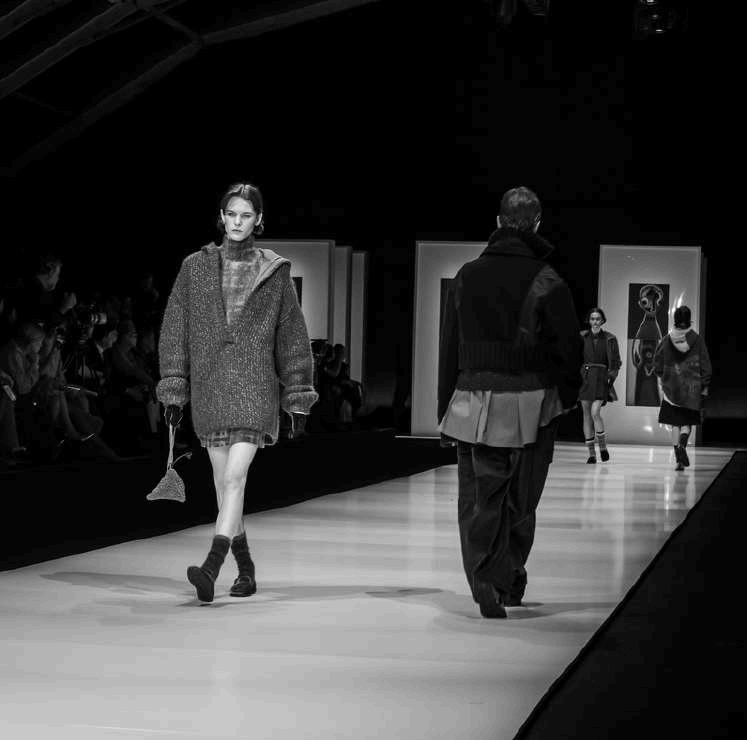


The color palette remained true to fall/winter traditions but was infused with depth and subtle experimentation. Navy blue, khaki, chocolate brown, and camel formed the foundation, while lighter shades of yellow, beige, blush pink offered softness and contrast. Unexpected accents of deep purple and cherry red punctuated the looks, adding richness and energy These brighter shades signaled the exploration of joy during chaos
Ogino, while in the vanguard of sartorial sensibility, has always eschewed loud seasonal trends in favour of building continuity across collections. Fall/Winter 25/26 was no exception, and the Ogino collaboration, while in alignment with Anteprima’s core values, opens up new worlds for the brand to evolve into. We can’t wait to see what comes next!
T H E W A Y
W E W E R E
Loro Piana remains the definitive last word in quiet luxury. The Fall/Winter 25/26 presentation, presided over by a team which inspired literal tears among guests due to the sheer passion with which they spoke about the clothing, reminded us why. Loro Piana is not merely a brand or an aesthetic - it is a century-old tradition and a vast international labour of love To wear a Loro piece is to engage with conversation with landscapes, artisans, and a harmonious way of being And to feel Loro’s finest fabrics, as guests at the presentation were able to, is to experience the pinnacle of modern science and timeless luxury.
To understand Loro Piana, one must understand the raw materials and human values that have always been central to the maison’s history. Sergio Loro Piana, who, along with brother Pier Luigi was instrumental in elevating “LP” to its current international acclaim, said that “horse riding is a school of life which teaches respect for the animal, perseverance, and discipline ” This is in many ways a metaphor for the Loro Piana design ethos, which demands nothing less than perfection, and, as the maison does not have a creative director, is centered on a selfless team spirit that has been nurtured for generations.
Fittingly, the Fall/Winter 25/26 collection also transcended time. It was inspired by a decades-old photo of Sergio riding, which the design team then used as a foundation for a nuanced equestrian-themed sartorial journey from Scotland to Argentina to New Zealand
There were obvious riding references - for example, riding caps, ascots, and stirrup-inspired buckles - while the luxurious tan-dominated colour palette, long a Loro signature, firmly anchored the collection in the equestrian universe. Other colours, all endemic to an aristocratic countryside lifestyle, included green haze melange, fancy galles visso, espresso, dark brandy, deep oak, tundra soil, creamy vanilla, grey melange, and fondue fudge
Perhaps the biggest news for Fall/Winter 25/26 was the introduction of Royal Lightness Yarn, a revolutionary material that marks the world’s first ever blend of silk and merino and was developed over a painstaking two-year research and experimentation process at Loro’s facilities in Roccapietra and Quarona. To produce the yarn, merino wool measuring just 13.5 microns (to put this in perspective, just 0.05% of the annual global production of merino wool falls between the 13 and 18 micron range) is combined and spun with Royal Silk measuring just 21 deniers The result is an almost impossibly thin gossamer that stands as the softest material I have ever felt. It was presented to guests alongside the also-new Royal Lightness Fabric, which blends the royal silk with cashmere for a lustrous - and sumptuous - result.
While knitwear highlighted this season, one would be amiss to not discuss Loro’s iconic leather products and accessories Key protagonists from the women’s collection included the new Needle Bag, inspired by the sinuous bags used to carry knitting needles
There was also the always-classic Loom bag, which pays tribute to the maison’s artisanal spirit in Nubuck leather colored a refined tweed. On the men’s side, a leather-trimmed linen garment bag should prove a must for travelers this coming season - whether they are carrying threepiece silk suits for business meetings or the brand’s coveted quilting hunt jackets for a cozy fall getaway Finally, sunglasses were introduced for the first time ever - bold yet refined, contemporary yet classic, the statement pieces perfectly epitomize the Loro clientele
To attend a Loro Piana presentation feels akin to a fashion pilgrimage (and not just because the fabrics come from all over the globe). At a time of rampant consumerism and high-valued shock value, Loro has stayed true to its belief that the finest fashion whispers rather than shouts. It’s refreshing - and much-needed.
ZONA20'S TRIBUTE TO SOLITUDE
In a time where fashion relies largely on modern relevance, classical literature proved an unexpected muse for Zona20's second consecutive capsule collection. The display, largely inspired by Gabriel García Márquez’s One Hundred Years of Solitude, was unveiled once again during the craze of Milan Fashion Week. However, you need not be versed in Márquez’s soulful literature to appreciate what the brand chose to convey
For young houses such as Zona20, the first appearance following a debut can often feel more defining and legitimizing than the debut itself For this second collection, Zona20 used the walls of a rather obscure warehouse in the southeast side of Milan to transform a literary masterpiece into a visual one. The bleakness of the backdrop was tactically offset by models posed atop scaffolding, an intriguing approach reflecting the brand's preference for providing something raw rather than overly curated Synthesizing Asian and Italian sensibilities, Zona20 conveyed both timelessness and craftsmanship through a sleek yet resolute display, resistant to a world plagued with short attention spans and overconsumption. The tenderness of non-confrontational textiles juxtaposed with the severity of leathers spoke to the collection’s literary inspiration and
Márquez’s philosophy that society’s struggles, byproducts of flawed human nature, are both cyclical and seemingly predestined.
Two Cienaga Coats represented the best translation of this philosophy into form. Time, often characterized by ripples, wrinkles, or even fragments, was woven through each undulating detail, echoing the convergence of past, present, and future Meanwhile, the coats’ palette of muted blues, fading seamlessly into concrete slate-gray, embodied a fluidity that extended beyond time to the brand’s gender-neutral ideals This design underscored the futility of male/female fashion rivalry and questioned the importance so often placed on it. Two more gender fluid looks offset this subtlety with a slightly more avant-garde aesthetic. Black leather trenches offered a flash of Matrix-like futurism while the softness of underlying sweaters maintained softness while inviting intrigue.
To reduce the takeaway of this collection to “quality” would feel unfair; this term is too often applied to brands whose only claim to the trait is their price tag Zona20 instead reminded its audience of what artisanship truly entails. Even its name, drawn from European zones with a 20 km/h speed limit, signals a commitment to deliberate execution and gradual innovation.
By remaining small in scale, the collection suggested that quantity not only fails to define quality but can often distort it. Within its Fall/Winter 2025 offering, Zona20 demonstrated that less can, in fact, be so much more.
ELEVENTY: QUIET LUXURY MEETS CONTEMPORARY COOL
WORDS: JESSE SCOTT
PHOTOS: LEROY VELASQUEZ
Eleventy has been electrifying the Milanese fashion scene recently, and Fall/Winter 2025 was no different. THe Italian heritage brand has been undergoing a youthful renaissance, with its contemporary and versatile silhouettes becoming de rigeur in the wardrobes of Italy’s young, sporty, and stylish From cozy cashmere to effortless denim to sophisticated wool, Eleventy uses only the finest fabrics, this year even introducing a rare yak fiber perfect for indulgent winter layering Meanwhile, the brand’s timeless colour palette, based around elegant shades of beige, grey, and white but also incorporating pops of dusty pink, rich burgundy, and periwinkle blue, remains chic whether in an urban or chalet environment.
Among the stand-outs this season?
Covetous corduroy jackets, quilted and belted vests, and flowing trousers paired with a wool blazer Furry textures were also prevalent, with knee-length sleeveless jackets proving particularly memorable
T H E R I T Z -
C A R L T O N
N I K K O
Nestled high in the mountains of the Toshigi prefecture, just three hours from frenetic Tokyo yet seemingly worlds away, Nikko is a haven of serenity in the Japanese heartland. It is here where the legendary Tokugawa Ieyasu, the first leader of the Tokugawa Shogunate and in many ways a father of modern Japan, was entombed in the early 1600’s It has been said that some 127,000 craftsmen contributed to the construction of his shrine, which remains possessed of a sacred grandeur and is revered by locals and foreigners alike Yet despite the region’s rich history, today it is the exquisitely preserved nature that is Nikko’s biggest draw.
Hundreds of kilometers of untouched forests, with a plethora of hiking trails but nary a human in sight, spread between pristine lakes, thundering waterfalls, and quiet creeks. Asiatic black bears lumber beneath the leafy canopy, while serows (an endemic goat found only in Japan) scramble along rocky ridges For wildflower enthusiasts, this is paradise; a rotating array of vibrant seasonal specimens colour the meadows from February to October And, in a time of rampant noise pollution and habitat destruction, Nikko seems ensconced in a bubble free from the scourge of mass tourism. Vacationing here feels like stepping into a bygone era, or perhaps forward into a new-age utopia where sustainable luxury and eco-tourism triumph over glitter and greed The RItz-Carlton Nikko, the region’s premiere property, greets guests with the mantra “nature and humanity are one ”
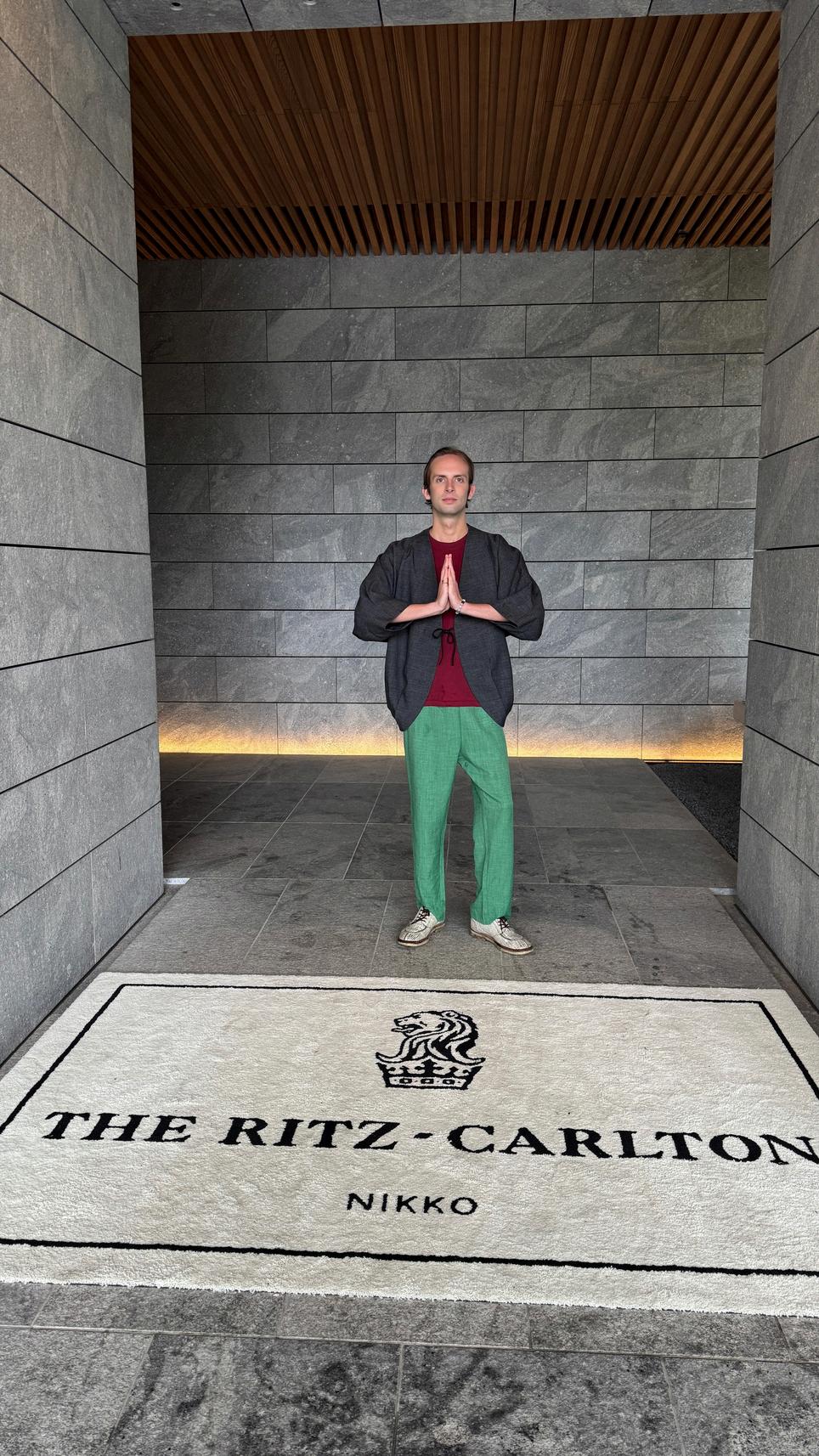
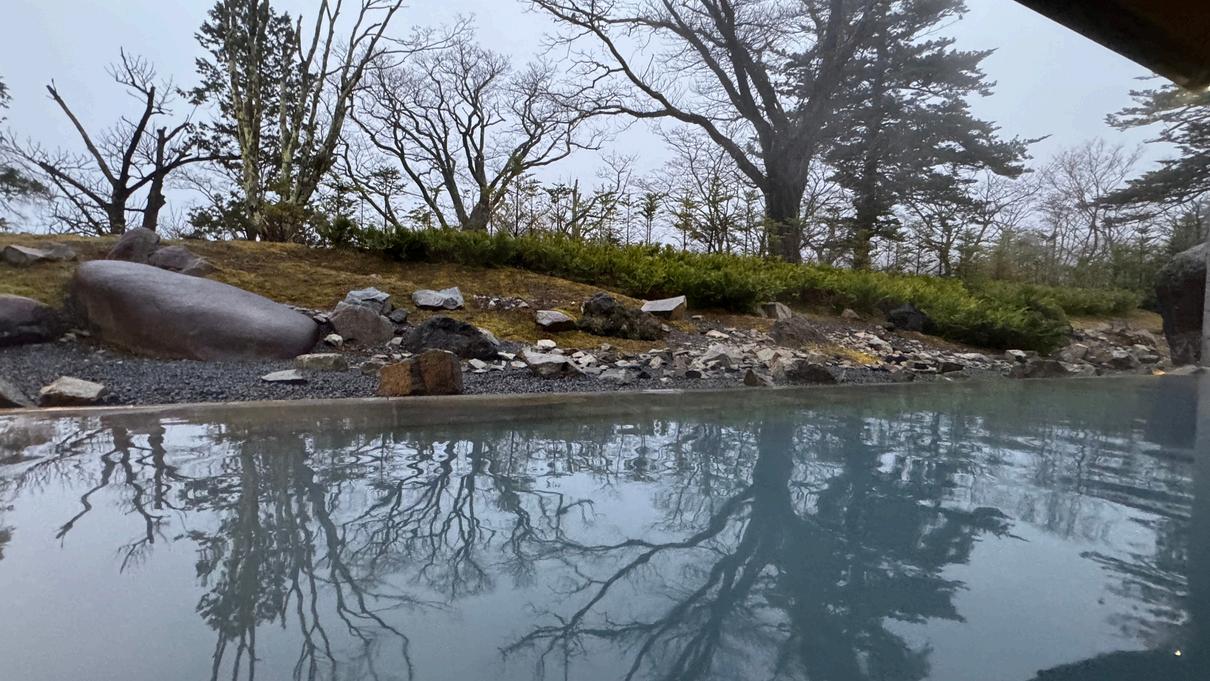
The ladies and gentlemen of the Ritz, and indeed the ladies and gentlemen of the entire prefecture, see themselves as custodians of the land rather than its beneficiaries, preserving its beauty and bounty for future generations while taking pleasure in sharing it with current guests.
I recently had the pleasure of spending three days at the RItzCarlton Nikko The drive to the lakeside property was unforgettable; climbing up the mountains via an interminable series of switchbacks, as a melancholic spring fog swathed the spring foliage and breathtaking cliff faces, I felt as if I was embarking on a pilgrimage. This feeling was reinforced upon my arrival to the hotel, an architectural masterpiece which has been built into the woods in adherence to the elegant Japanese minimalism that has so entranced the globe. Every aspect of the property, designed by Nikken Sekkei Ltd , converses with its surroundings without eschewing the latest in luxury
While fatally chic and possessed of modern sensibility, the Ritz-Carlton also remains firmly grounded in history. It has been constructed on the site of the former Lakeside Hotel, a traditional Japanese ryokan (tatamimatted inn and bathhouse) that opened in 1894. The 1890s were a “boom time” for Nikko, as the arrival of a new railway station created the potential for tourism and inspired the British delegation to Japan, the first of many foreign missions to fall in love with the region, to build an embassy villa there
Serene Lake Chuzenji, the highest natural lake in Japan, and the towering Kegon falls, which lie just a twenty-minute walk from the hotel, have changed very little since.
Each day at the Ritz-Carlton is an immersive experience in Nikko National Park. Beautifully appointed rooms offer floor-to-ceiling windows overlooking the lake, complete with swoon-worthy bathtubs and balconies from which you can see stars and sunrises From the tea-making sets to the elegant wooden furniture, the accommodations complement their cultural and natural environment rather than disrupting it. And when you step outside the hotel, you are just a five-minute walk away from hiking trails, kayaking, and stand-up paddleboarding.
Meanwhile, the “nature and humanity are one” philosophy is best exemplified by the onsen, a traditional Japanese sulfur hot spring which the Ritz-Carlton has interpreted for a discerning and mindful modern audience As a man of eastern European descent with a regular sauna/hammam routine, the onsen felt at once both profoundly familiar and unexpectedly foreign. It is a deeply ritualized part of Japanese culture, strictly gender-divided, generally requiring full nudity, and beholden to its own revered code of etiquette. And it’s one that I adapted to by my second day at the hotel, developing my own routine of sauna/shower/hot springs that cleansed my weary muscles after a hectic two weeks traveling around the country
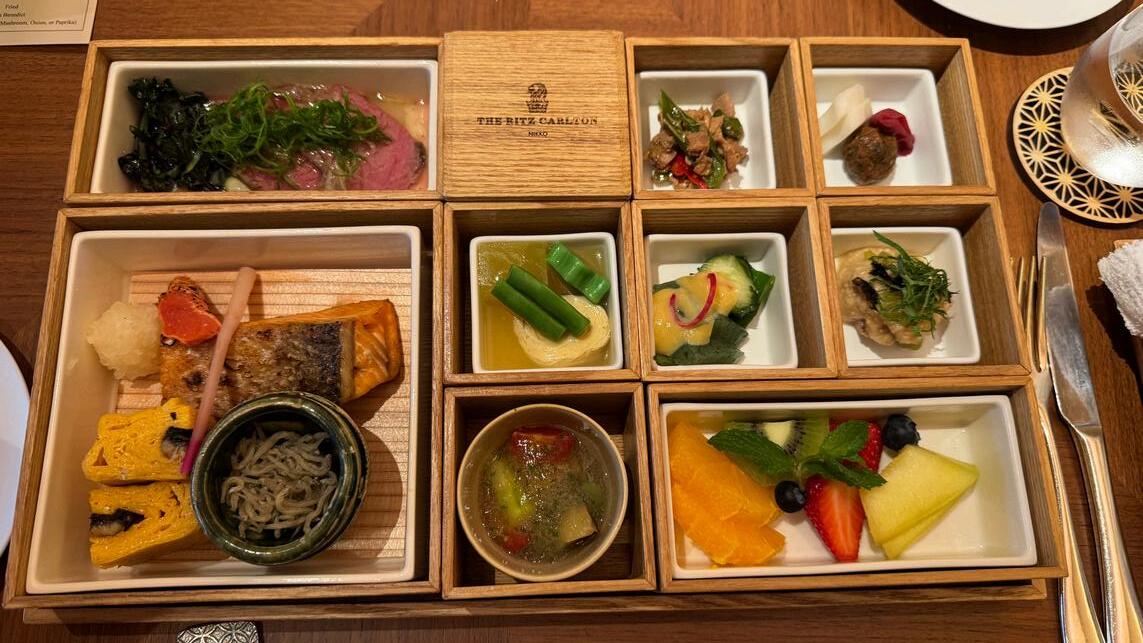
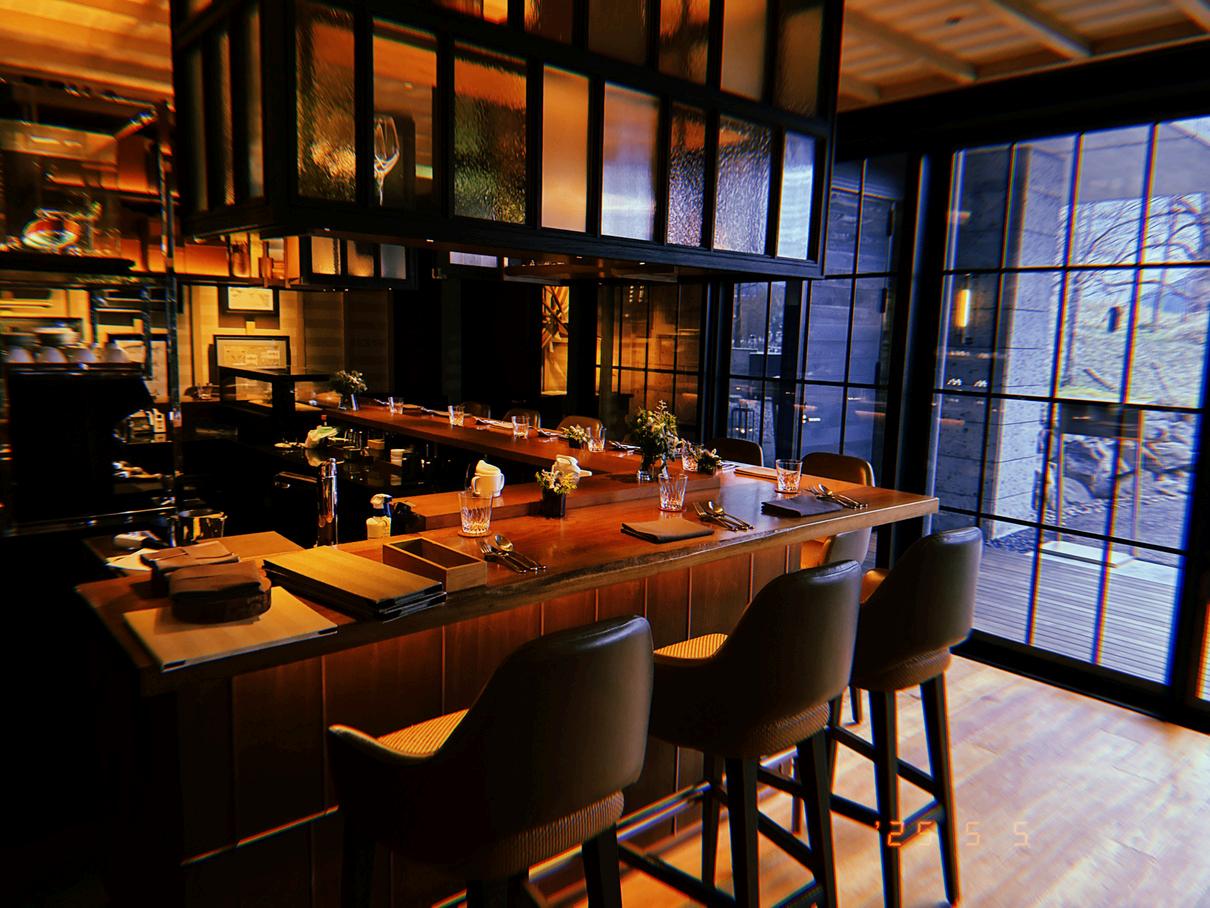
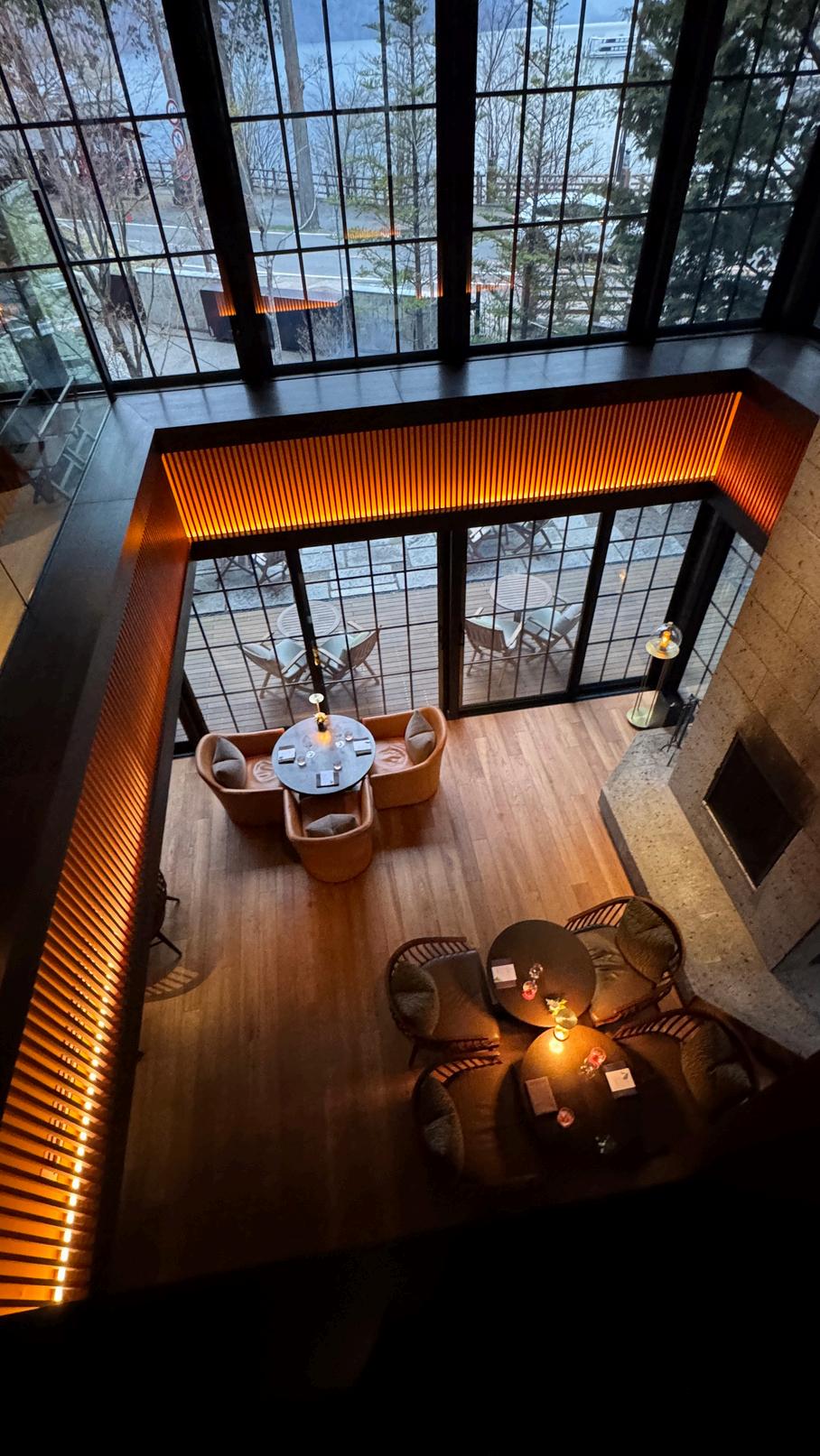
Nikko is a dream wellness retreat. And it has the ingredient-driven hyper-local cuisine to match. Two Michelin-starred chef Kanji Kobayashi, most famous for the restaurant Villa Aida, is the consulting chef. In a time where “farm to table” has become so ubiquitously used it has lost meaning, Kobayashi has brought “table to farm;” villa aida is literally based on his family farm I was treated to his cuisine in the form of a traditional ten-course Kaiseki dinner at The Japanese Restaurant on my first night at the hotel
Equally impressive was the Japanese breakfast, served on an expansive “bento box style” tray that included such delights as grilled cod roe with sardines and sansho pepper, saltgrilled silver salmon with grated radish, and local dried gourd with mustard greens and golden sesame sauce. The local mountain produce was omnipresent; flavours here are unique compared to anything else I encountered in Japan
The most memorable part of my stay in Nikko was a prayer bead ceremony in the Chuzenji Temple Sitting on traditional mats, I carefully selected and threaded my own beads, each one possessed of a particular protective power, into a bracelet. The beads were then blessed by a monk; I still cherish them as a reminder of Nikko’s powerful spirituality and the restorative sense of calm that I experienced there.
Leaving the temple on an early May afternoon to see Lake Chuzenji caressed by mist and delicate pink cherry blossoms, I felt truly blessed to have discovered this hidden enclave of Japan. Opened just five years ago, the Ritz-Carlton Nikko is in harmonious dialogue with past, present, and future, honouring its region’s rich heritage, offering a mindful escape for those who seek moments of solitude amidst stressful lives, and safeguarding natural and cultural treasures for our descendants.
It is more than a hotel: it is a spellbinding narrative And, like a cherished book, it is a place of comfort you may find yourself wanting to return to again and again
GETTING HERE: Most guests arriving by international flight arrive at Tokyo Narita Airport. From there it is a 2.5 hour drive to the resort.
PHOTOS:
1) The outdoor space of the men’s onsen at dusk
2) Morning stroll along Lake Chezenji
3) The elegantly minimalist entrance
4) The men’s onsen in the morning
5) Breakfast at The Japanese Restaurant
6) Cozy interiors for rainy days
7) Guest with the head chef at the Japanese Restaurant
8) Portal to the onsen
9) Outside Chezenji Temple
10) Cherry blossom season in Nikko
11) Prayer beading ceremony with a Buddhist monk
SPECIAL THANK YOU TO KEITH JUN AND THE LADIES & GENTLEMEN OF THE RITZ-CARLTON NIKKO FOR HOSTING ELYSIUM MAGAZINE
Cherry blossoms overlooking Nachi village
Pagoda at Nachi Falls
Our journey began with a bow. My landlord and lady had just pulled out all of the stops to provide my parents and I with one last great feast before we would begin a weeklong pilgrimage into Japan’s spiritual heartland In Japan it is believed good fortune and harvests represent the blessings of the gods of the land, the very gods whose shrines and temples dotted the rigorous seven day hike we would begin on the following morning It is also believed that before one begins a pilgrimage into the deep and winding roads of the Kii Peninsula, one should eat well with family. Having completed this dinner, us three Americans and our two gracious Japanese hosts bowed deeply each other in respect and thanks.
The route we were to attempt is known as the Kumano Kodo, or the Road of the Old Gods. It is mentioned in Japan’s two oldest texts, the Nihon Shoki and the Kojiki.
When the first Emperor, Jimmu, arrived in these mountains, he became irreparably lost within its labyrinthine twists and turns However, the gods of the land, recognizing in him a spark of divinity, sent their messenger, a three-legged crow, to guide him out of the mountains It led him to a gently bending river at the foot of the mountains, and it is there he founded Japan’s first capital, Yamato, six hundred and sixty years before the beginning of the Christian calendar Eventually, shrines were established and paths were worn into the mountains by pilgrims, peasants, and princes who sought to retrace Jimmu’s steps, offer gratitude, and beseech the old gods for good harvests, fair weather, and divine guidance.
20 minutes after we departed my town of Kamitonda, a local bus deposited us by a bridge overlooking a small brook. It was an unremarkable place to begin a journey; a small information center to our right and a torii gate ahead of us were the only indicators this particular mountain road held any significance Inside the tourist center, we bought several protective amulets which we affixed to our hiking bags The clerk dipped her head as she handed us our change Like a river that has worn its way through the mountains over millennia she wished us well with a practiced bow and tested voice Another tourist couple we had met on the bus bumped into us as we prepared to depart. With hurried bows and focused smiles we said we hoped to meet again, perhaps at the first rest site of the journey, before eagerly starting off.
We stood before the first torii gate, a large and unvarnished thing of solid wood. Purple banners flapped in the wind in the space beyond the gate leading up to a small wood structure A torii gate in Japan represents the divide between the sacred and the profane Careful to avoid walking through the center, where only the gods may tread, we bowed in reverence, went up to the wooden shrine, and prayed We deposited yen into a small box, swung the heavy rope vigorously to awaken the sleeping god, bowed twice (once shallow, once deeply), clapped twice, and bowed a final time. This is the manner in which one prays, and considering we would see several hundred shrines over the next week, it would become a ritual well worn into our bones. I tried to think of something to pray for, but the easy breeze, mid-spring sun, and the quiet sounds of the forest stilled my mind into nothingness. After an instantaneous eon, we continued to ascend the mountains.
It took us all of fifteen minutes to understand that there exists a serious discrepancy between the American definition of a hike, and a Japanese one We found ourselves clambering over boulders and up forty-five degree inclines The path, wide enough for only single-file climbing, threatened cascading cliffs to either side Nothing, save for our own balance and the will of the gods, prevented us from tumbling into darkened canyons We took frequent rests, bodies and backpacks bowed over, and clutched our amulets tighter than we had when we started. Our first two hours took us only a kilometre into the heartland but nearly half a kilometre into the air. We emerged from this initial section bent but unbroken, and continued higher into the mountains towards our first destination.
At the end of our initial ascent stood the town of Takahara. The ridgetop settlement is home to only around 300 souls We sat on a ridge and watched the last of the morning mists burn off in the valley below A local sold us coffee and orange juice (a specialty in Wakayama Prefecture) As we rested our feet beneath 1000 year-old camphor trees we bumped into our friends from the start of the trip They, themselves graduates of several other pilgrimages, looked worse for wear than we did They planned on returning to the city that afternoon, before taking increasingly long bus rides back into the mountains to continue the trail.

We talked for a bit before our sore legs began to remind us we had many more miles to make before sunfall and we bid them farewell, knowing it was likely the last time we’d encounter each other on this trip This was how friendships tended to go on the trail People bound by a common cause and a solitary trail become friendly, depart, and never meet again I hope they finished the hike safely and returned to Australia
Light was failing as passed a statue dedicated to the 65th emperor. Supposedly it marks the spot where, after traveling for several days from Kyoto to here, he stopped with his retinue for tea. Finding some red substance on the sleeve of his robe he asked, “blood or sweat?,” giving the town of Chikatsuyu its name. By this time we had covered around 20 kilometres of hiking and our socks and shoes were stained with plenty of each substance. I have never been so grateful to see the lights of civilization than I was as we descended the cobblestone path into Chikatsuyu. We stopped by a small general store to buy water and, most importantly, beer A man with more fingers than teeth asked where we were planning to spend the night “On the other side of town,” I replied and he laughed “You’d better get going, light won’t last much longer ” He bowed as we walked deeper into this town of 400 people The last we saw was him lighting a cigarette under the awning of his story as he waved us farewell
We slumped to our lodgings, sloughing off clothes and packs. We were staying in a recently constructed house, and our host met us at the door, bowing deeply. He told us dinner would take about an hour to prepare. After showering and changing into the provided robes, we ate in his kitchen with his wife, while he sat by a computer liking hundreds of instagram pictures in an effort to get more views for his own business We confirmed our early departure the next morning, and all slipped into a soundless deep sleep
The morning of the second day began with the realization that despite my relative youth, I was not in mountainclimbing shape Sore legs and a mind desperate for another hour of sleep made me doubt whether myself, and my parents, would manage to complete another twenty kilometres of hiking. Thankfully, the second day proved less rigourous than the prior day had. A short way down the road we encountered another shrine, surrounded by a grove of cedar trees.
They were 60-80 meters high, and their branches grew in the direction of Nachi Grandshrine; one of the Three Grand Shrines on our route Below the shrine, a small store sold memorabilia The proprietor excitedly chatted to us as we counted out our dwindling coins As it turns out, she had retired only a few years earlier from the town in which I lived More protective amulets were foisted upon us as we continued
It was mid spring, so not only was the weather mild but the first cherry blossoms were beginning to emerge from their winter slumber. Small houses, many of them slumping into the mountains from disuse, sold cold drinks; cans sitting under cold, natural spring waters cascading down from the mountains could be yours for the low price of a few hundred yen. There was no one to collect the money, so we laid them beside the trickling water like votive offerings. The second day of hiking truly took us further from “civilization.” Indeed, I believe we saw more vacant houses than filled ones Along roads and mountain paths trees stood as straight as school children reciting their morning prayers to the emperor and the health of the nation By now we had settled into an easier rhythm of walking The deep silence of the woods pressed itself in upon us, broken only by the sound of the wind and the bells of our charms rattling against heavy packs
We made better time than expected, and arrived in Yunomine, a hot spring town, by early afternoon. A gruff old woman huffed about us arriving early, telling us to return in an hour when the rooms were ready. She begrudgingly allowed us to leave our bags in the lobby, and curtly informed us that we were not to arrive late to dinner. We bowed, apologized, and returned to the center of the town. Later that night, after dinner and a nightcap at the only bar in town, I encountered a gargantuan Japanese man roaming the halls of the inn, obsessively polishing the hardwood He had large headphones on and sang in an offkilter tone that led me to believe that perhaps he was on a spectrum Then I suddenly realized that perhaps this was to account for some of the gruffness from our host Our early arrival may have thrown a wrench into the delicate machinery of their quiet lives in this tiny town When we departed the next day, I tried to bow a few inches more deeply, and thanked her using a regional dialect only employed by grandfathers from deep in the mountains. She lit up in an instant and laughed and asked where I learned that phrase. She wished us well and asked us to return sometime. I promised that I would.
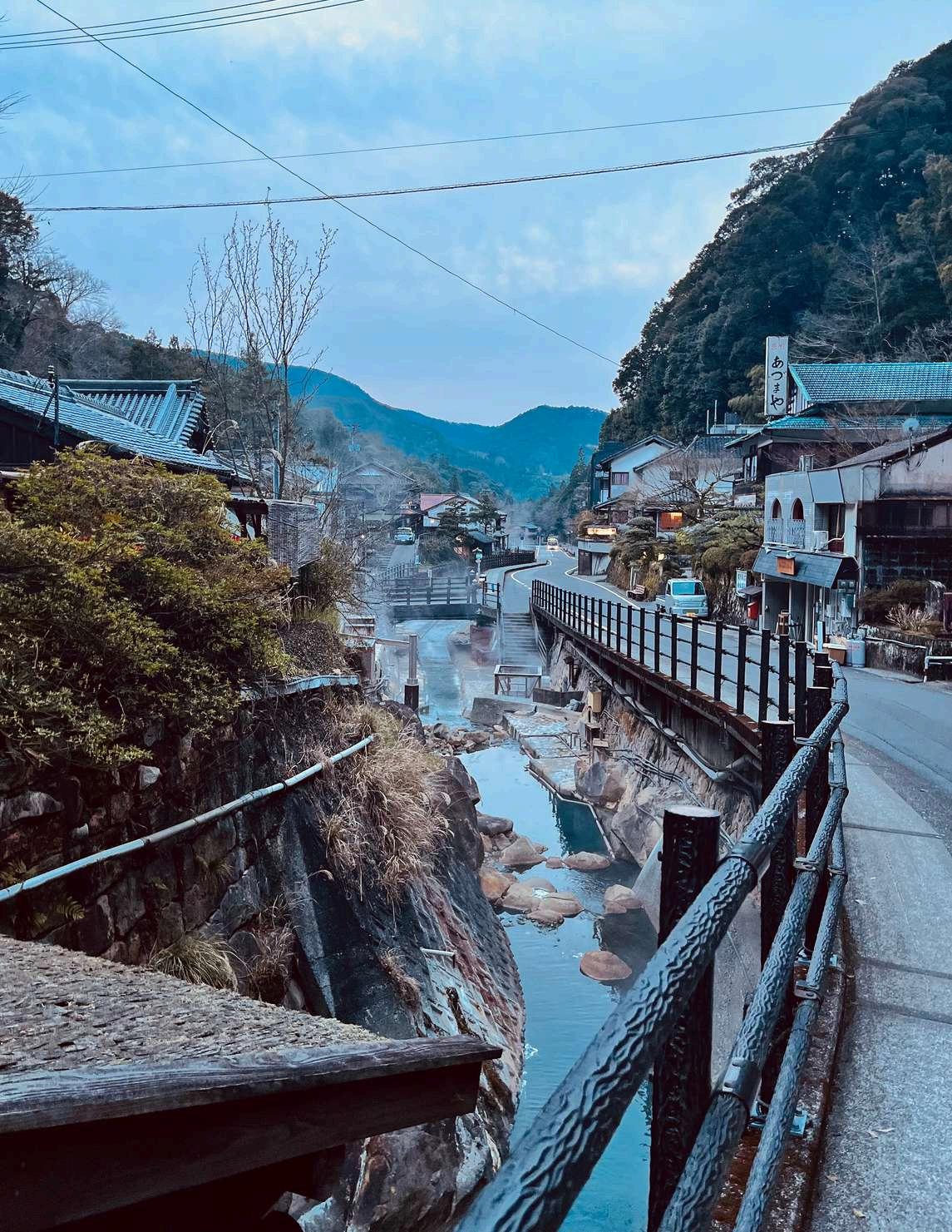
That day would see us circumambulating the first of the three grand shrines, a place called Hongu Grand Shrine. Compared to each of the prior days, it proved no problem As we rounded the final bend, we spied the torii gate, the largest in Japan It stands alone besides a shadow of the once great Kumano River In older days, the river had overrun its banks and nearly destroyed the shrine itself; only the gate, (34 meters tall by 43 meters wide) remains in its original place The deities have been re-interred further up the mountainside, away from the winding waters of the river.
One of the idiosyncrasies of Japanese Shintoism is that a deity can reside in multiple places. It can drowse happily in the little wooden structures of a shrine or cavort in the wilds like a Gaelic fairy. It can exist in the town of Hongu and simultaneously at a shrine on the other end of the country. A second peculiarity compared to the Abrahamic religions is that Shintoism and Buddhism, in Japan, are nonexclusionary Both are separate and distinct, yet woven together like two strands of thread into the fabric of Japanese spirituality
For example, Hongu Taisha contains worshipers from three distinct religious traditions To the far left of the inner sanctum stand three shrines to the Buddha of the past, present, and future respectively The central and largest shrine contains the Kumano deities, indigenous to these mountains. In fact, the central Kumano deity is believed to be a version of the Buddha, born as a kami. To the far right resides the Sun Goddess Amaterasu, progenitor of the imperial family. To worship in front of one shrine does not prohibit one from bowing before another. And indeed, we watched a steady stream of worshippers proceed from left to right, performing the same ritual again, and again, as their ancestors had before them
The Kumano River, which had once washed away Hongu Grand Shrine, winds its way from the northern Kii Mountains before terminating into the Pacific Ocean near the city of Shingu, and the second of the three grand shrines At this point we decamped from the typical pilgrimage route, instead opting for a boat ride to Shingu in the style of 10th century nobility. We disembarked close to the shrine, bid farewell to the latest set of travel compatriots, and prepared for the second of our shrines.
Nothing had made a small city of 20,000 people seem more metropolitan to us than four days spent in the wilderness carrying our lives on your backs For the first time in half a week we heard urban ambient noises After stowing our bags in a coin locker (another urban amenity I will never again take for granted), we walked the short distance from our disembarkation point to the Grand Shrine dedicated to the flowing waters of the river that have sustained life here in Shingu since the earliest days Bowing before the gates and the thousand year old trees, we gave thanks for not having to carry our bags for at least the next several hours. One other funny thing of note: to the side of the final gate before the inner sanctum stood a green, coin-operated payphone (yes they still have payphones). It cost a dollar a minute.
Nearby was another more ancient shrine called Kamikura Shrine. Its ascent is famous for both its severity and length; indeed the first half likely exceeded forty-five degrees over crumbling stairs However, at the top exists one of Japan’s most ancient shrines A gigantic rock nearby is believed to be the place where the gods first descended to the earth A second, gentler path exists, but its entrance is flanked by signs warning of highly venomous vipers The shortcut to heaven is evidently lined with danger Not for the first time we climbed up the mountain with hands and feet, but at the top we were granted an uninterrupted view of the city and sea from the mountaintop.
The final destination on our trip was the sleepy seaside village of Katsura. We arrived by train (another modern marvel I will never take for granted again) before being ferried by boat to our hotel further out on the peninsula. The hotel was the Hotel Urashima. Four separate buildings assumed commanding positions overlooking Katsura Bay. A fleet of staff awaited our arrival, jumping to attention to load bags onto bellcarts as we checked in Afterwards we were personally taken up the stairs and through the tunnels carved into the mountains to our room on the opposite side of the bluff overlooking the Pacific We had arrived at high tide, and so we watched the waves crash into the jagged coast below us The windows were soon thrown open to allow the sea air and the sounds of the ocean to fill the room.
The Hotel Urashima may once have been a great beauty. But that former starlet had aged in a venerable and silverhaired maven of the stage. Lush red curtains have given way to soft pinks while once lacquered wood now holds small scratches and scars; testaments to a life well lived. The sprawling hotel complex contained two buildings facing land, one the sea, and another perched on the summit of the peninsula, looking towards the sunrise The onsens, carved from the caves below our feet, earned Urashima its fame, and tuna fishing earned the town its praise The otoro (fatty tuna) at the hotel was, indeed, spectacular
By contrast to all the previous days of walking, reaching our final shrine in Nachi proved a cinch The paved path led us through the forest at the bottom of the mountain, past switchback roads, through the small hamlet which had grown up around the shrine, and finally to the shrine itself. By now, the sakura buds that had begun to emerge at the beginning of the trip had reached their zenith, covering the opposing mountain sides and canyons. Amid verdant green groves of coniferous pines they clung, like insubstantiated pink clouds drifting through the valley below us.
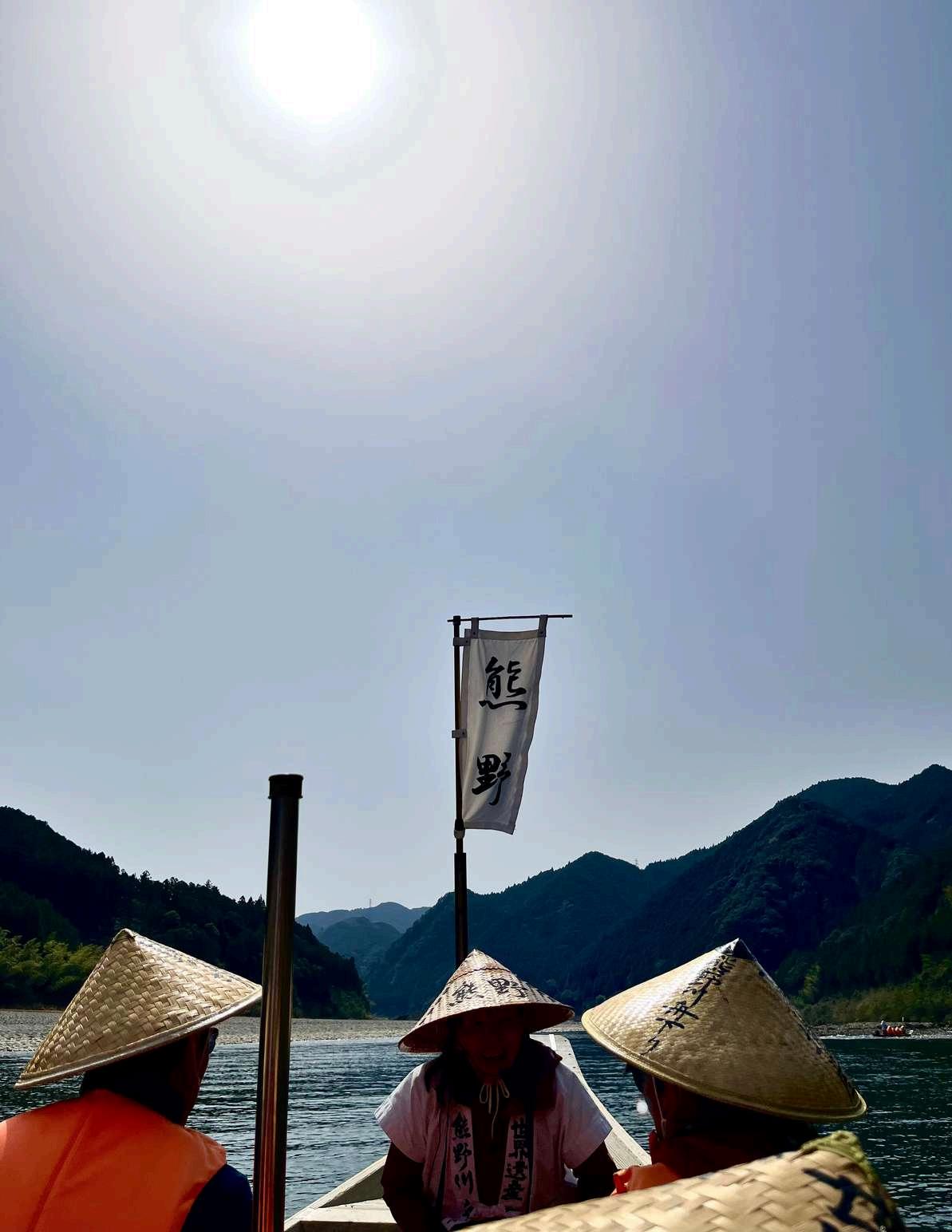
Many Japanese consider Nachi the most beautiful area of Japan. The shrine overlooks a valley into which pours Japan’s largest waterfall. A radiant vermillion pagoda provides an uninterrupted view of the waterfall from its highest level, or a luminant red contrast to the verdant greens of the valley. Though clouds threatened (but never delivered) rain, it is impossible to stand on the top of that mountain and not feel like you are in the presence of some higher power
And then, all too soon, it was time to return Out of the woods we walked, packs slung over shoulders for a final time With legs sore and backs arched we boarded a midday train, leaving behind the sacred woods for the unconsecrated lowlands. Soon we’d trade our boots for brogues, tech-shirts for button downs, and wide-brimmed hats for properly maintained hair. The deep silence of the woods would give way to the sound of cars, shuffling papers, and the voices of co-workers.
Rafting the Kumano River
Soon we’d trade our boots for brogues, tech-shirts for button downs, and wide-brimmed hats for properly maintained hair The deep silence of the woods would give way to the sound of cars, shuffling papers, and the voices of coworkers. Mundane concerns of alarms, deliverables, and meetings would replace the simplicity of the trail, of the ever-looming countdown of the setting sun, when the only thing one had to do was walk, and not stop walking.
Though it felt sad to return and leave the sacred for the profane, I hoped one thing would remain: an increased understanding of the depth and breadth of emotion conveyable by a bow
From the practiced bow of a clerk selling amulets to travelers, to the one of genuine gratitude towards a recently made travel companion you will not see again, I wished to remember it all in blazing colors While some things fade away on the trail, others intensify, like the taste of a beer after a long hike, or the solemn look of an abandoned building lost in time.
We traveled the road of the old gods, but what I remember most were the brief relationships formed along the way Though much is taken, much abides While I may not be that pilgrim who climbed mountains and forged across rivers, that which I am, I am An unequal temper of human heart, made weak by time and circumstance but strong in will; to strive, to seek to find, and never to yield.
Walking through Ipposugi
















